It’s been a while and you may have missed the most recent blog post. Never fear, you can find it here!
In the spirit of Paddy, my reflections have taken some time to set down. This section is long, both in coverage and text, and is perhaps best read in multiple sittings. For those who are still eager for a dénouement, fear not: I made it, and my writing will too.
A brother on the Wallachian scene
The next afternoon, I found myself waiting in the northern outskirts of the Romanian capital, a suburb called Săftica. And there soon drew up a face and figure I had sorely missed over the last months: my younger brother, having just finished school, had come to meet me in Wallachia! After a celebratory meal, we bedded down at our roadside hotel, which appeared to double as a wedding venue.
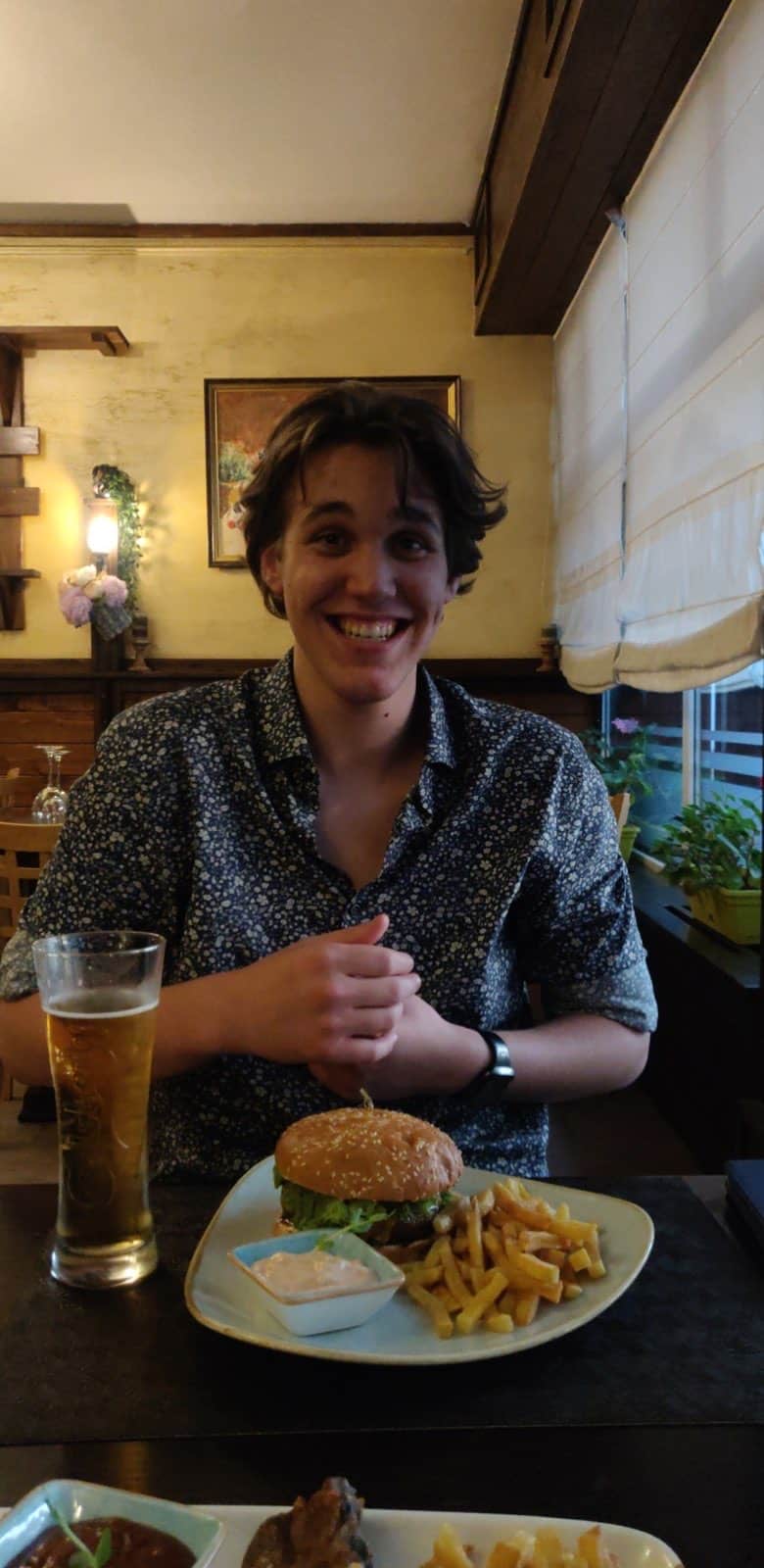
The next day we trudged into the capital, mainly following the hard shoulder of the northernly road which ingressed into the centre of Bucharest. This would come to constitute the majority of our shared walking on his brief trip, and gave a little taste of what was perhaps the less glamorous side of my journey: walking down the side of the main duel-carriage road, fuelling up at Lidl and service stations. However, it wasn’t long until we reached Otopeni (the home of Bucharest’s airport) and we cut east off the road, skirting elegantly round a wetland area. We soon reached the centre of town.
We spent the next couple of days exploring the capital, which I had been lucky enough to have visited with a friend last summer; leading our way around the old town in almost proprietorial fashion, we Lime-scootered about for hours on end, surveying the Arcul de Triumf (a reminder of the historical influence of French culture in Romania) nestled within the King Mihai I Park, and toured the periphery of Ceausescu’s People’s Palace.

A waterway reunion pending
Together, we walked out of Bucharest through the Communist blocks to the south of the city, and it wasn’t long before the bustle and concrete had fallen away, and we came to pass by villages, where chick hatchlings ran amok in the front yards. The walking was hot and difficult, and the exercise in the heat of the day soon became overwhelming; by a remote quarry, we hopped into a nearby stream in an unsuccessful attempt to ward off my brother’s eventual succumbing to heatstroke. A long day in 40 °C heat was an unfair introduction for him to my Great Trudge.
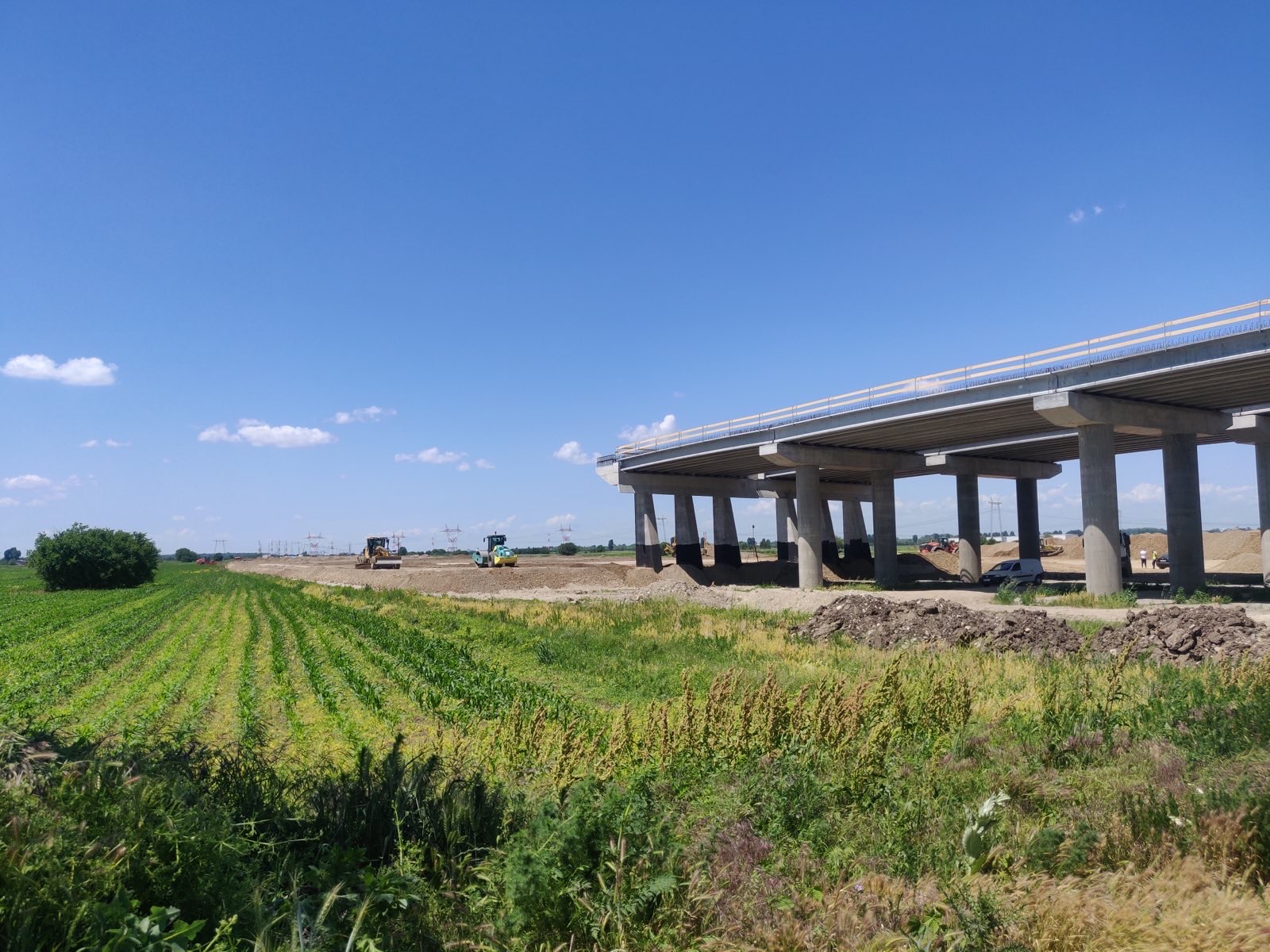
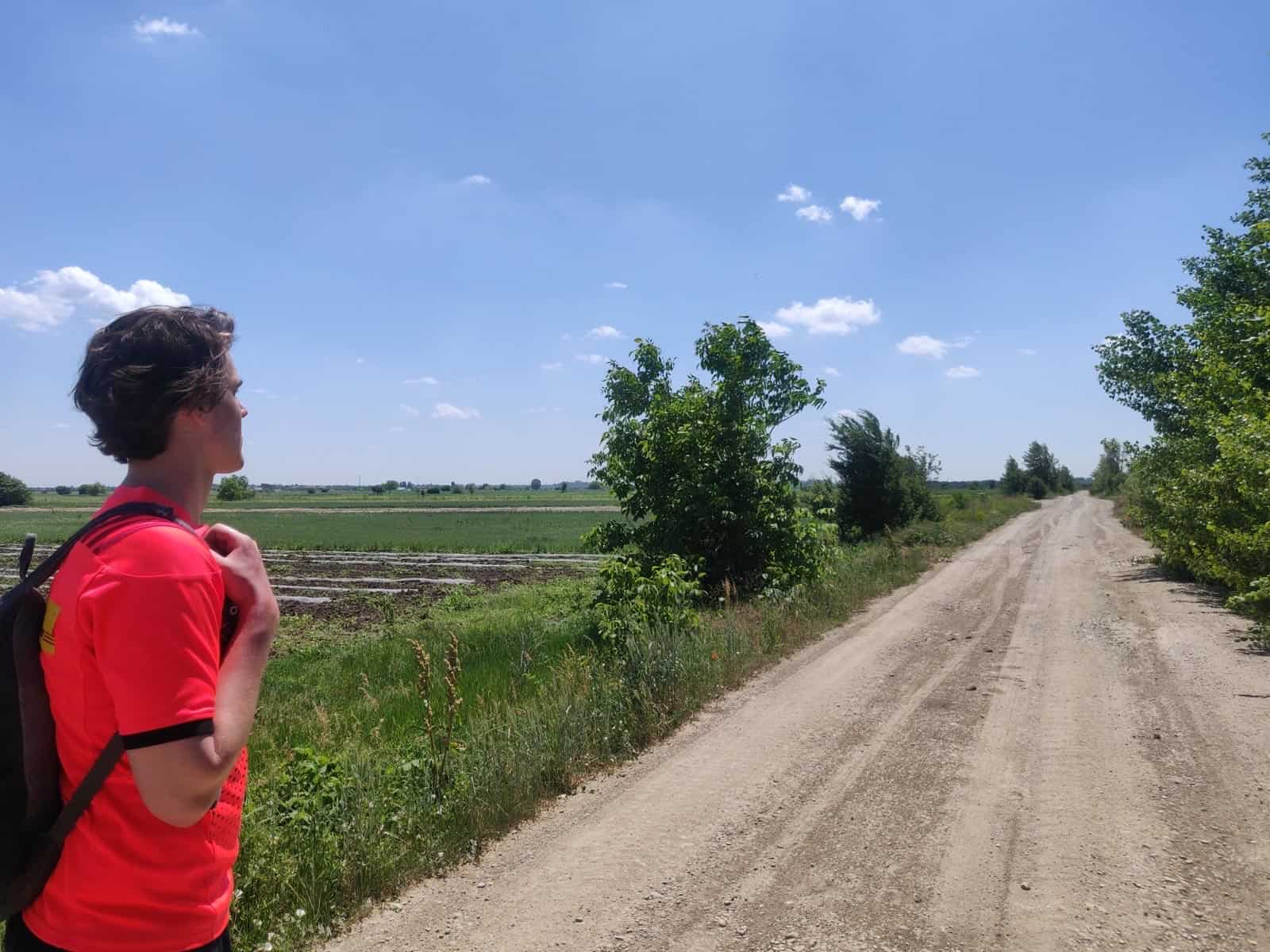

Not long later, outside a village convenience store, we procured vehicular onward transport for my brother, and I walked on. Grassy wheat meadows, lit warmly by the late afternoon sun, had an enjoyably Provencal feel to them — they saw me safely through to the end of the day and my brotherly reunion at our billet in the small marsh-side town of Comana.

The following day, after an unexpected and delicious fry-up of tomatoes and mushrooms for breakfast put on by our hosts, I set off alone, in the small hours of the morning: a long, long day was in the offing – quite how long I was yet to discover – as I headed toward the Romanian–Bulgarian border where I would meet with my brother.
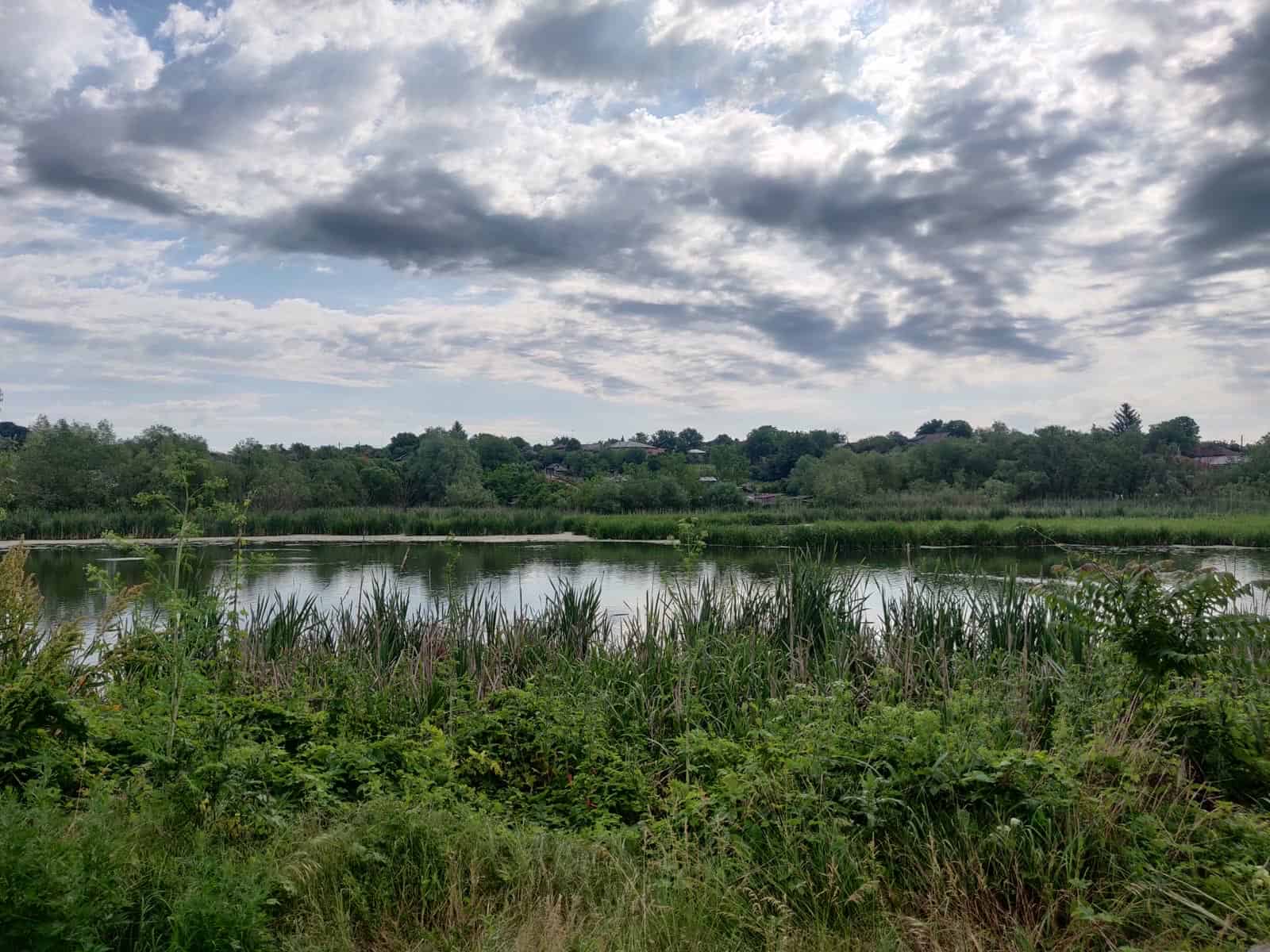
Through fields scattered with poppies red and lavender purple, I walked for hours on end. I passed through the hamlet of Vlad Țepeș and later refuelled my water stores at the far western side of Pietrele, before descending 100 odd meters into a vast plain that had emerged below me to the south of Baneasa. An expanse of crops stretched for miles before me, and on through them I tracked, dodging a few small packs of dogs, en route — quite the canine mark of foreshadowing, in retrospect.


It was to the sounds and song of pigeons, buntings, and cocks, that I came and soon went from Gostinu, my final Romanian town. I took shelter from the sun in a collapsing bus shelter, but could afford no more than a few minutes. And so, the silly man wandered off in the heat of the day, the inhabitants of this sleepy village no doubt bemused by this foreign hermit with a pack, heading at an inexplicable pace through the countryside.
Crossing the Danube
It was soon after, that I laid eyes on my old friend, the Danube. Many long weeks had passed since my departure from its banks back in Budapest, and many more since my depositing of my old wooden staff in its Viennese currents — each piece of driftwood I now spotted drifting between the Balkan nations served as a reminder and memento of those first days along the Rhine, many months ago. I found my feet in the Germanic woods and cities. Those oh so heady days.
A note to explain my route: Paddy walked to the Iron Gates and then went on a car tour of Transylvania. Dispelling the idea of a car tour, but certainly eager to walk through Transylvania, I had taken a more northerly route out of Hungary, straight into the Romanian mountains, before heading south towards Bucharest. This trajectory ultimately gave me a Bulgarian experience that was never on offer to Paddy.
I followed along the curving banks of the river. Catching the old view of its waters through the breaks in the trees which lay between us. I passed cattle roaming in the forest by the river, and then through a herd of goats in the middle of my path. To the north, I spotted a shanty town with metallic corrugated roofs glinting off in the distance, the home of the herdsman, it seemed.
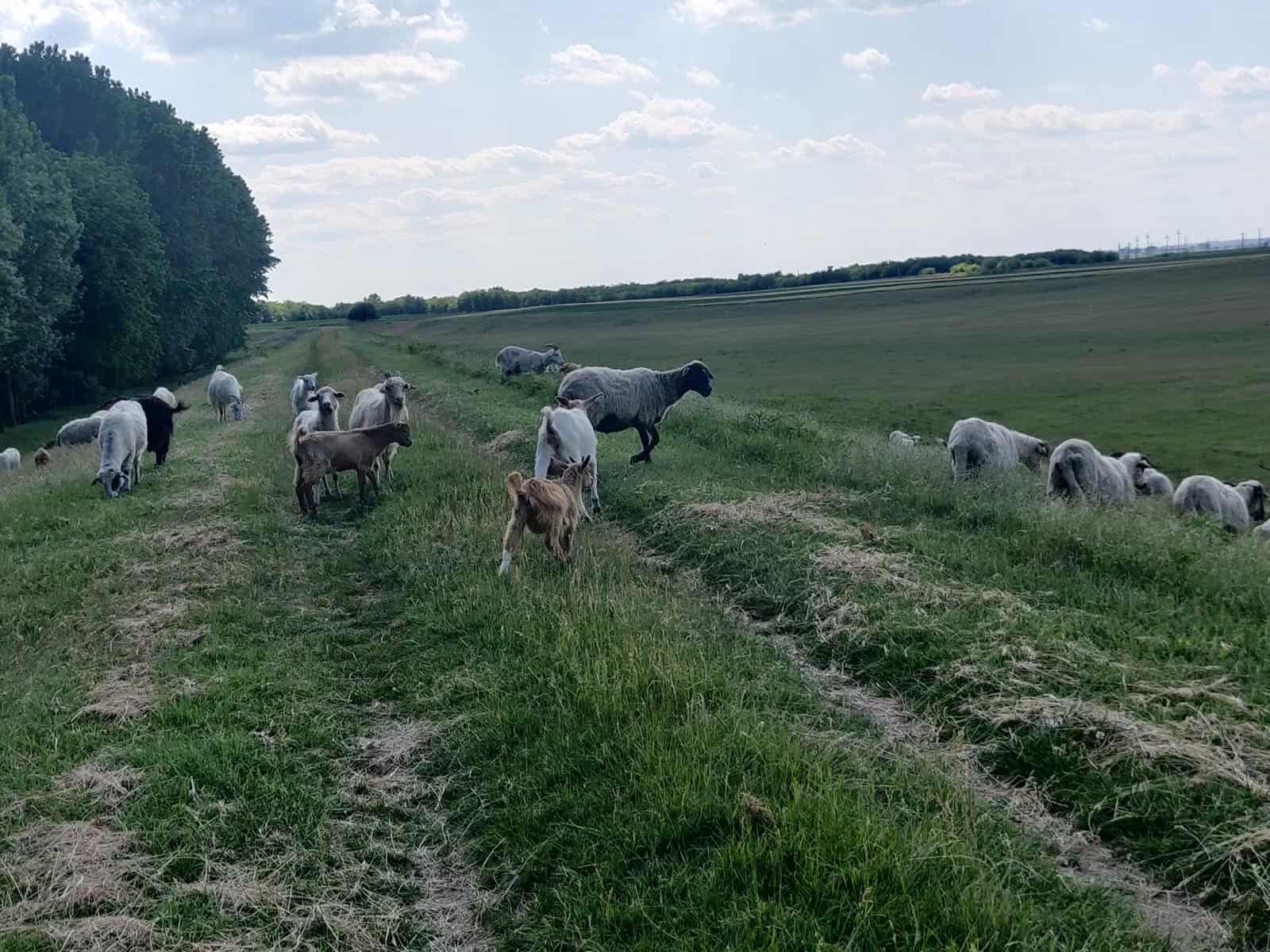
As I sat on a rock outside a remote house catching my breath, a pack of dogs emerged down a path, barking and running towards me. Panicked, I grabbed a wooden board on the ground nearby, arming myself: after the mutts had stopped their pursuit, I noticed a large rusty nail sticking out the top of the wooden board — a close call on all accounts.
I soon turned off the river, angling back north-east towards the border crossing. It was in this way, scampering away from yet another pack of strays across an exposed field, that I eventually arrived in the middle of a great mass of road transport bound for the bridge over the border. At a service station, I once more rendezvoused with my brother, who arrived sporting my pack on his back and his bag on his front, like a babybjorn.

The border guards observed us bemusedly as we walked along the hard shoulder and the middle of the road, heading for the bridge. Soon, they had ushered us through, and we made our way across the Friendship Bridge. (That said, the bridge itself was not exactly the expression of ‘friendship’ between the two nations that it once must have been — in days of old, it must have been quite a feat of Soviet-era engineering, but the vast iron construction had not seen a lick of paint, let alone repairs, since its construction in the 50s.) The pain and extreme weariness of the day was dampening the mood. But, we soon crossed the rickety walkway, not likely used by pedestrians for some years.


Standing over the middle of the Danube, I glanced back to Romania, a surprising and wonderful section of my walk, and forwards towards Bulgaria, its forested shine beckoning me towards experiences new. My last country before Turkey.
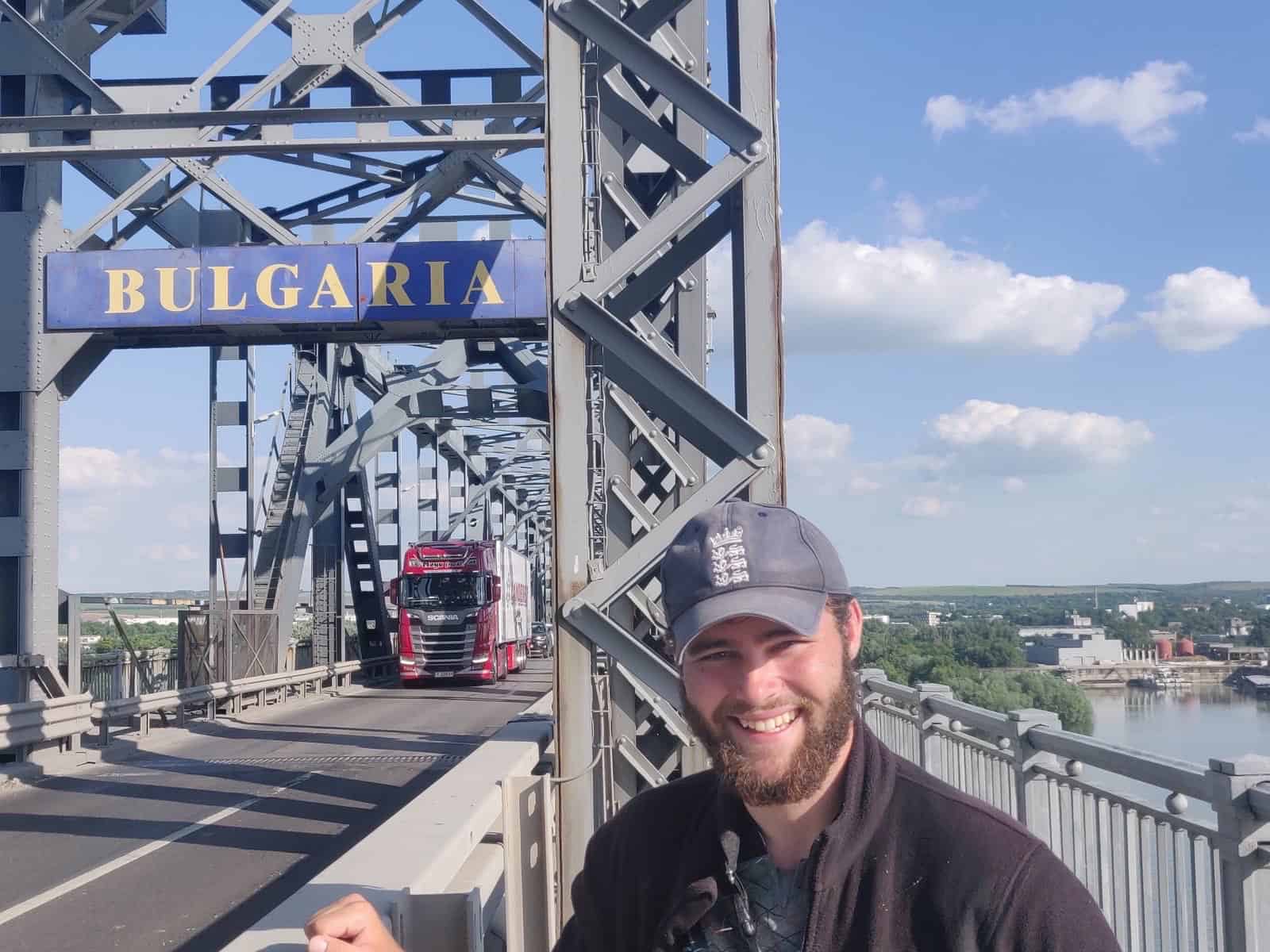

Ruse
The bridge deposited us to the west of town and an hour or so later, having walked through an area of communist blocks and parkland, we drew up in the centre of Ruse and collapsed into our hotel for the next two nights. After a long shower, the open plan design of which I would come to recognise as distinctively Bulgarian, we headed out into town for a celebratory dinner just off the main square, ploshtad Svoboda (Liberation Square).

The celebration was due on multiple accounts. I had spent over a month in Romania and grown so fond of the country and its vibrant tapestry of peoples and histories; though it was hard to say goodbye, a new challenge now presented itself in the form of the first Cyrillic and conclusively Orthodox country of the walks. The day had also marked — and not by design — the longest day of the trip and my life: I had walked 37 miles (61 km) in one day, and I was exhausted. There was a certain fitting irony (for posterity’s sake) that my brother was there to witness one of those great and memorable days.
Transliteration bests translation
A few years ago, whilst at school, I was lucky enough to try my hand at Russian. Though I’ve scourged from my mind the final public exam result, the superficial summary of that year of lessons, the year of study had loosely stuck with me; if that time had done anything lasting – bar arming me with the odd verb or phrase of Russian, recalled only on random and irrelevant occasion – it was arming me with knowledge of the Cyrillic alphabet: once I’d warmed up, transliteration of signs, maps, and menus would not be a problem. Comprehension, on the other hand, is a different matter! But at least I was not totally all at sea having left the Latinate world.
A humid and overcast day of touristing followed the next morning, before my brother departed the scene having seen me safely over into Bulgaria. He headed west for Sofia, and I trudged south.
Rock-hewn monasteries
I headed out of Ruse, through the industrial estates to the southwest: the town seemed hemmed in by industry, be it on the river or inland. Walking under grey skies and light patches of rain, I made my way towards the valley containing the Rusenski Lom Nature Park. With my orange waterproof cover now spread across my pack, I continued out in the countryside, shortly stopping at a family run restaurant that I had noted on the map for shelter and a coffee. Armed with directions and the results of a short Bulgarian lesson from the waitress, I set off once more.
By midday, the errant pilgrim drew up at the Rock Monastery St. Dimitar Basarabovski, affectionately shortened to Basarbovo. Founded in the 12th century during the Second Bulgarian Kingdom by wandering hermits, the site was small, but exceedingly tranquil and beautiful. A small group of Bulgarian tourists accompanied me on my visit; through the entry gateway, I hiked up the stone cut rocks to where various enclaves housing chapels and icons had been carved into the sides of the cliff. The danger of falling rocks, although very real, seemed lost amid the inherent charm of the place; though the chalky-white, crumbling rocks forming the walls and floors flaked off to the touch, the rock-hewn caverns held an earthy, solid quality. The orthodox church and (still inhabited!) monastic dormitories imbued an enchanting quality, with rich blues and other paints covering the walls and curved roofs. By now, the sun had begun to emerge from its refuge behind the clouds.
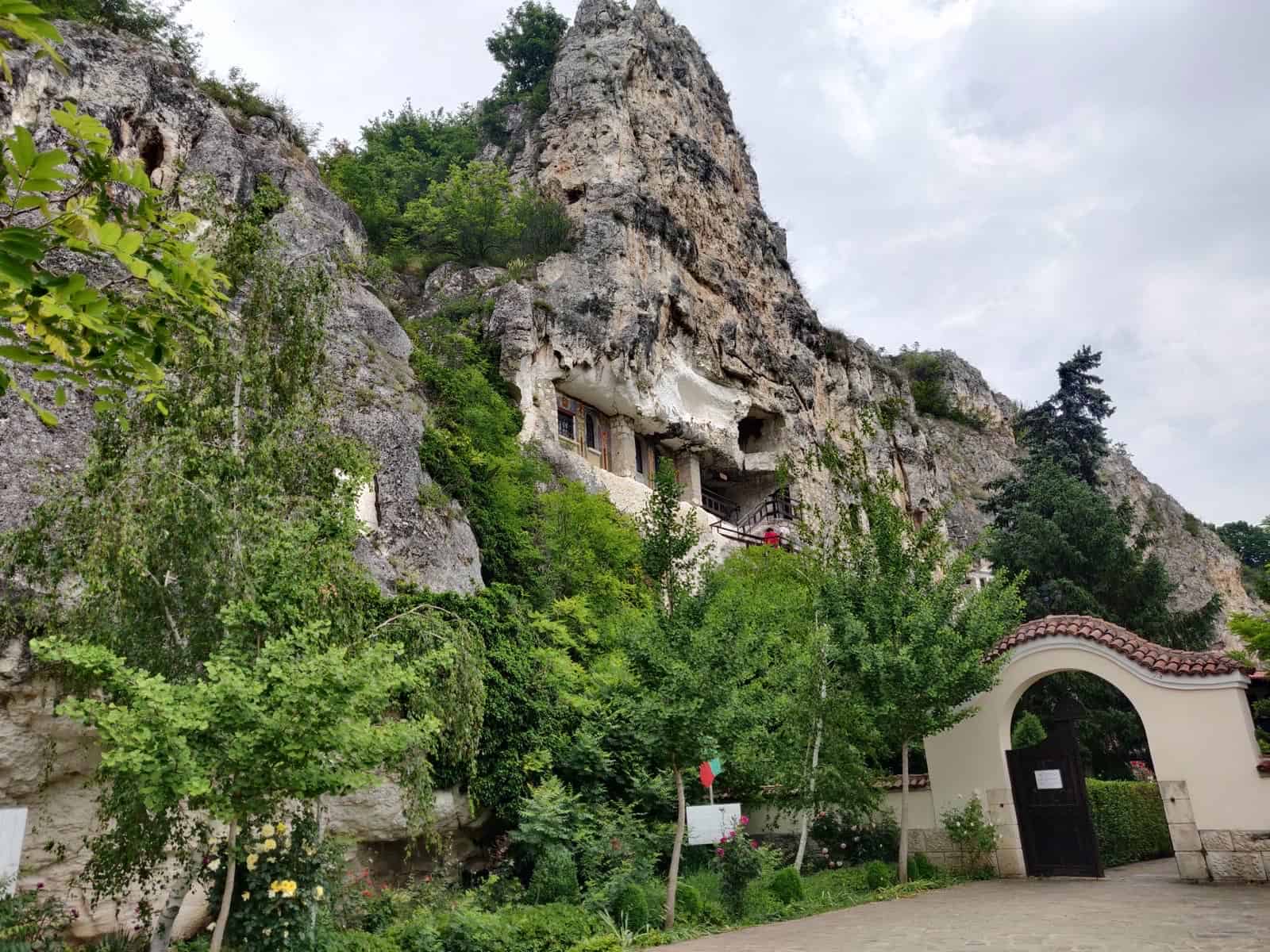
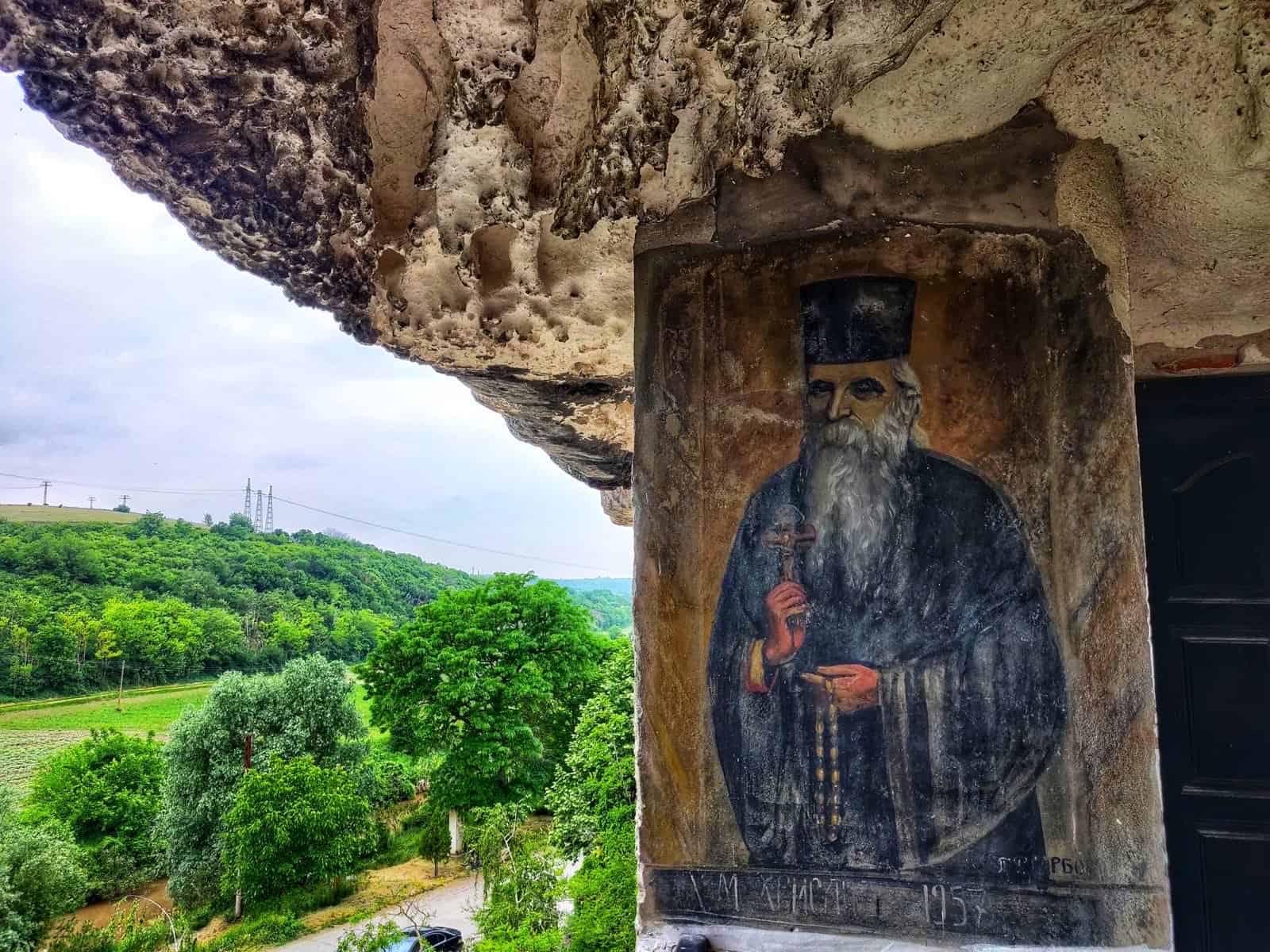
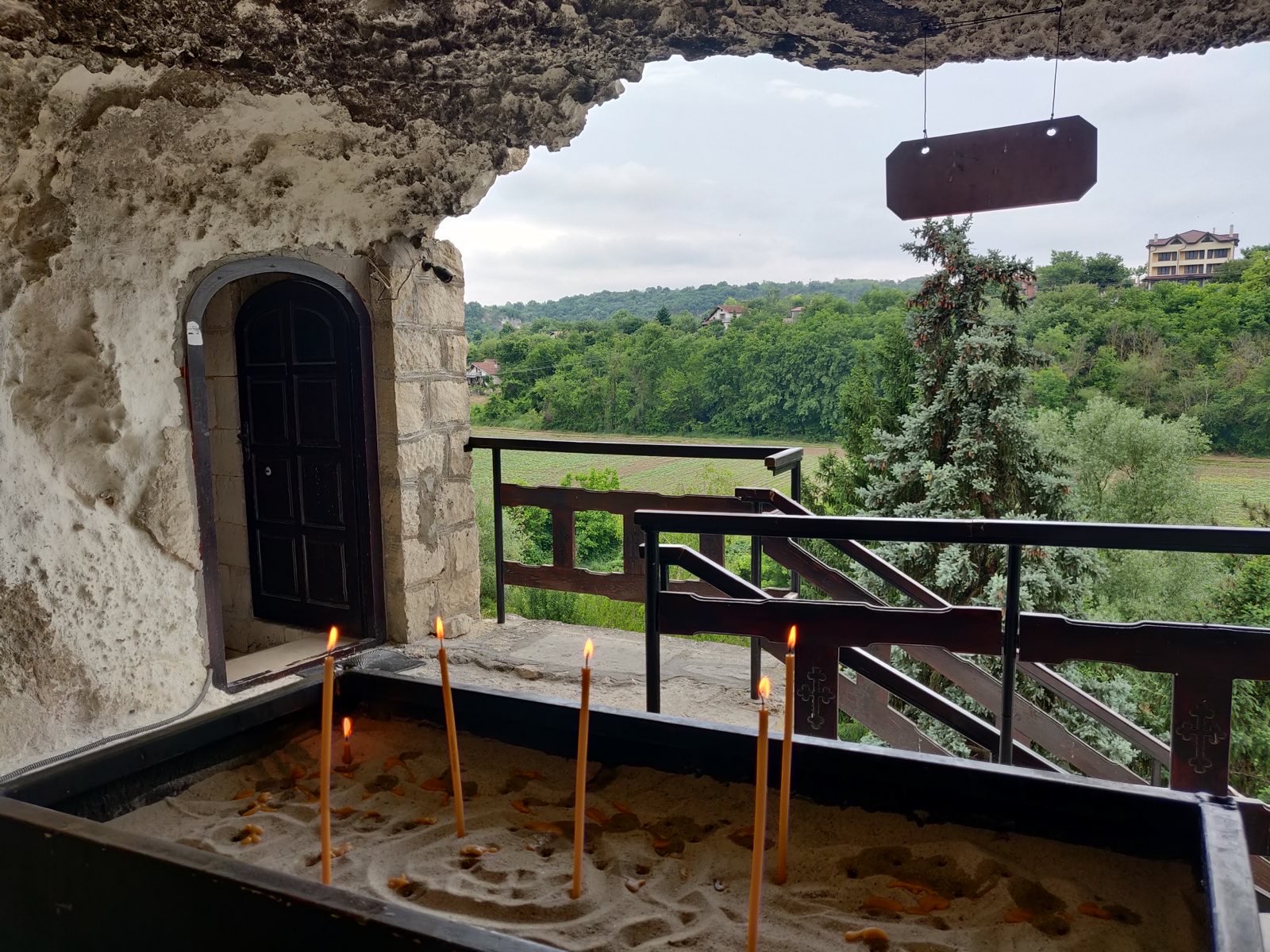
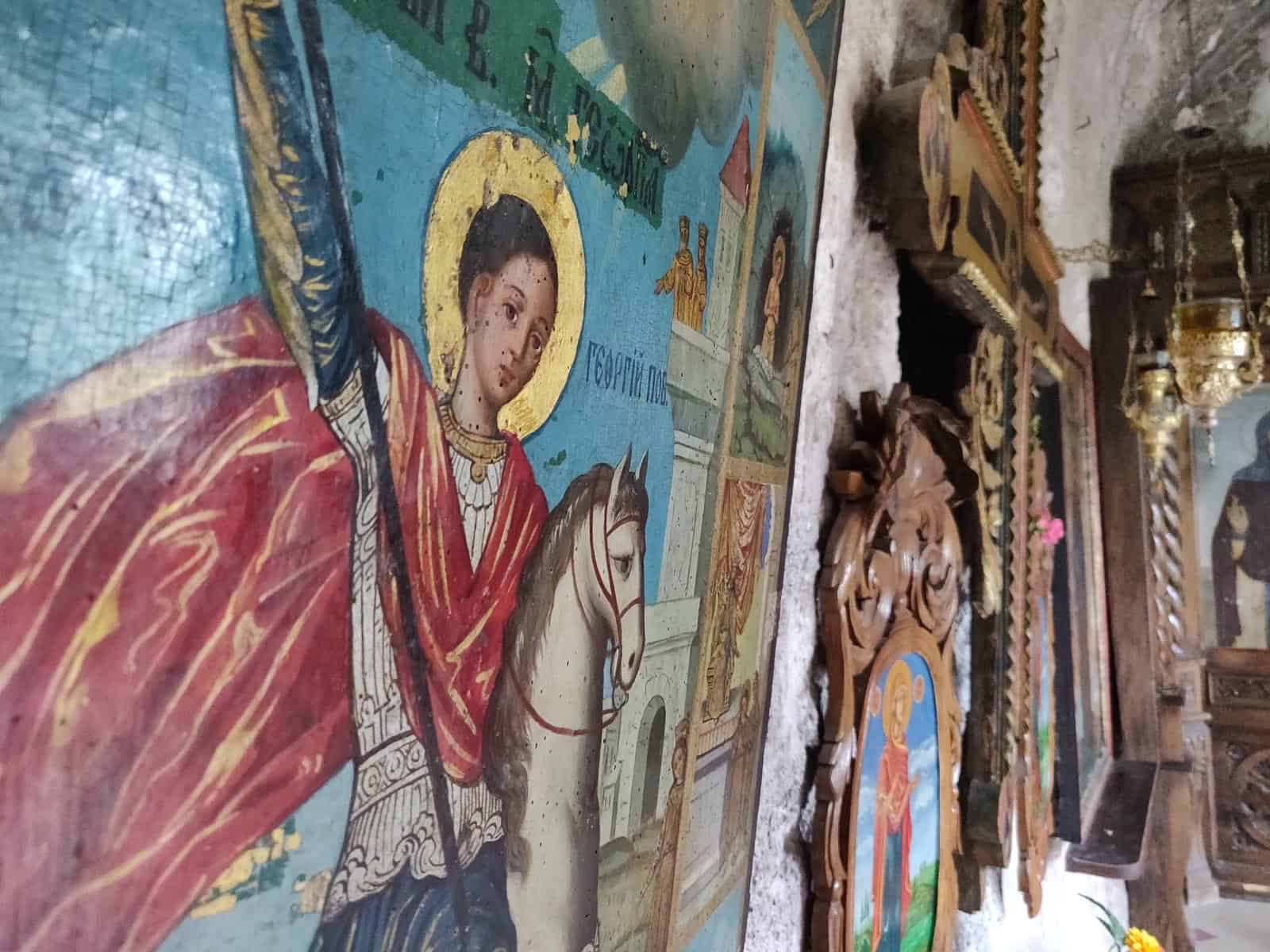
Back walking along the “main” road between towns, I passed a flock of ducks sporting amusingly long wattles, which hung down to their withers, swinging as they waddled across their pasture. Boy, did they have a lot to say, as I passed. I was glad for the conversation.

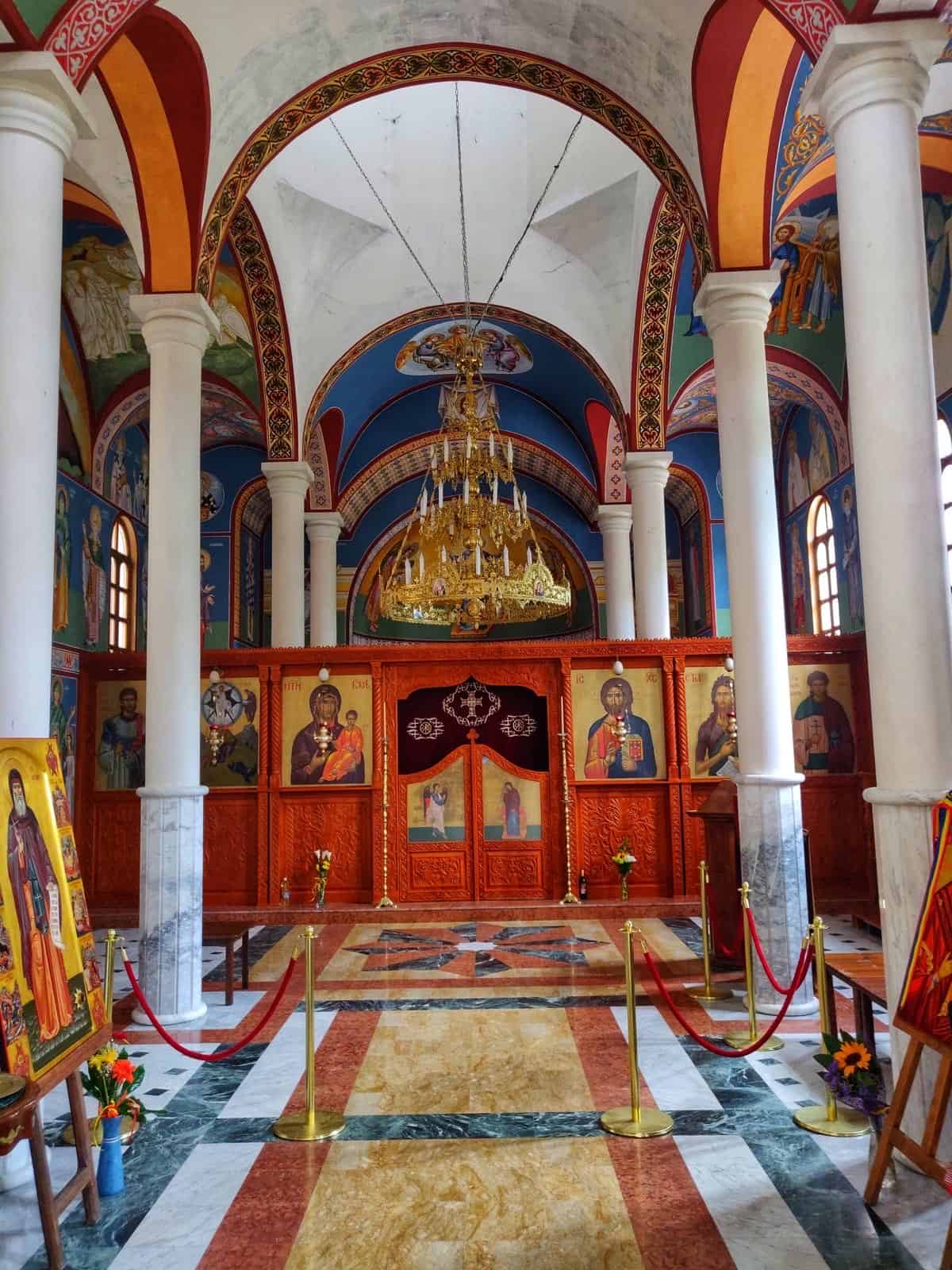
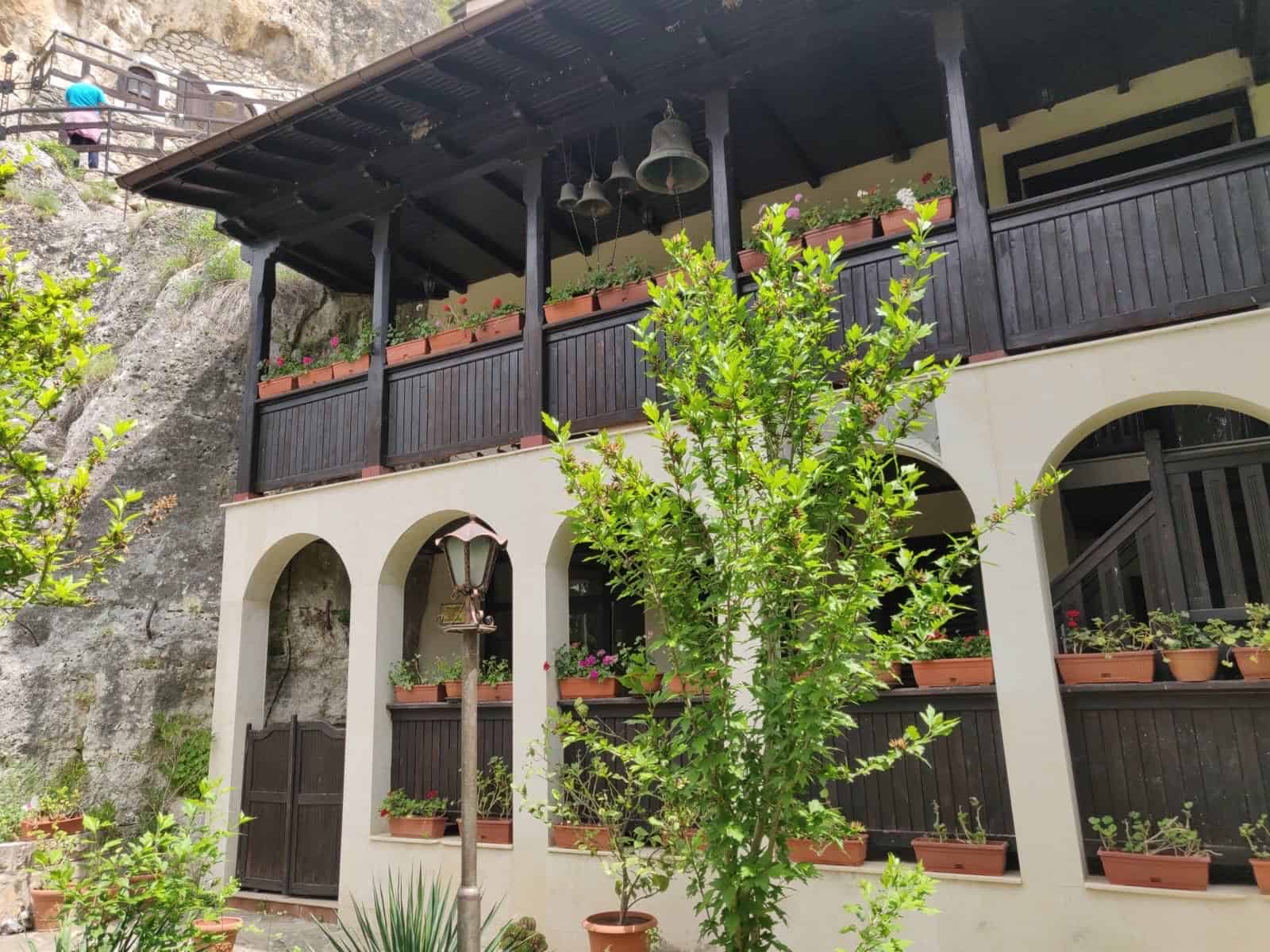
In the early afternoon, as I sat catching my breath to the side of the path, I heard a faint rattling noise coming from the shrubbery, but thought little of it. Then a few minutes later, out of the bushes, a metre-long grey snake emerged, uncoiling as it slithered on by, nonchalantly.
Not far at all from my destination for the day, Ivanovo, a motorcycle, one of the few vehicles I had seen that day, pulled over, and the leather-clad driver enquired where I was headed. The proud driver had polished his now-gleaming silver Yamaha bike till it shone black and silver. He gestured for me to hop on, and I certainly wasn’t going to say no! It was a truly exhilarating ride: having been so unexpectedly launched into the middle of a Hollywood movie, I held on to the man’s shoulders we hurtled down the winding road, wind pulling at our cheeks. I must have looked rather odd with my pack still on, half-clinging to the stranger in front of me and half-clinging to my shorts to stop my pockets giving way — I immediately pictured myself a lady, attempting to keep her skirt from blowing up whilst on horseback, all the while smiling giddily. Oddly, Lady Mary Wortley Montagu sprung to mind, crossing the Balkans almost three centuries prior, as she accompanied her husband on his embassy to Constantinople; she had considerably more status and style, but even less comfort.
A mere three minutes later, I was deposited a kilometre or so outside Ivanovo. And for the duration of the day, I daydreamed of riding my own cycle on a remote Ionian island.
Ivanovo
It took me almost half an hour to gain entry to the pension I had contacted, and when I did, I discovered that they only accepted cash — I just had enough. And there was no ATM for some 10 miles. My attempts to pay the two stores in town which accepted card and receive it back as change were unsuccessful. Cash – or rather the lack thereof – was suddenly a slight issue on the trip. On the whole, Eastern Europe has modernised extremely fast on the card front in the last decade. Romania, Hungary, and Slovakia were almost entirely unproblematic — even in rural areas. In fact, they were no more or less accepting of cards than Germany and Austria, which I often found to be rather reluctant on this front, especially given the former’s technological reputation. It is poignant at this juncture too, to mention my witnessing in Bulgaria of the last vestiges of an old age of travel: where Euros, Pounds, and Dollars would also be commonly accepted, not just Bulgarian Leva. Alas, I had none left, bar a single Euro coin that I would later use to gain admittance to a museum.
Still searching for cash, I tried my luck in another restaurant across the way. Upon entering, the interiors were covered with wooden beams and white plaster, I had entered a world of 17th Century Central European mystic design; it was the sort of ancient of Balkan tavern I had hoped to stumble into. I asked the 30-something year-old women if they accepted card or knew of any way I could find cash. She didn’t speak English, but promptly provided her 6-year-old son, who spoke it fluently and provided top-notch translation and interpreter skills. Though I left empty-handed, in a matter of minutes the contrast of old and new, an emerging Bulgaria, was stark and telling.
I walked an hour or so from town, across and down into the valley where the Rusenski Lom (river) runs, in search of Ivanovo monastery. Through the trees, past a car park and gift shop, I again began the climb up a cliff-face. Soon, a narrow crack in the rock appeared before me, which formed the entrance to Ivanovo’s rock-hewn monastery. Dating from around 1360, this monastery is no longer active, but this added a certain “abandoned” charm to the space, where biblical frescos adorned the walls. The far wall had collapsed during an earthquake in the 16th Century, leaving a gaping hole through which to survey the greenery of the valley below.
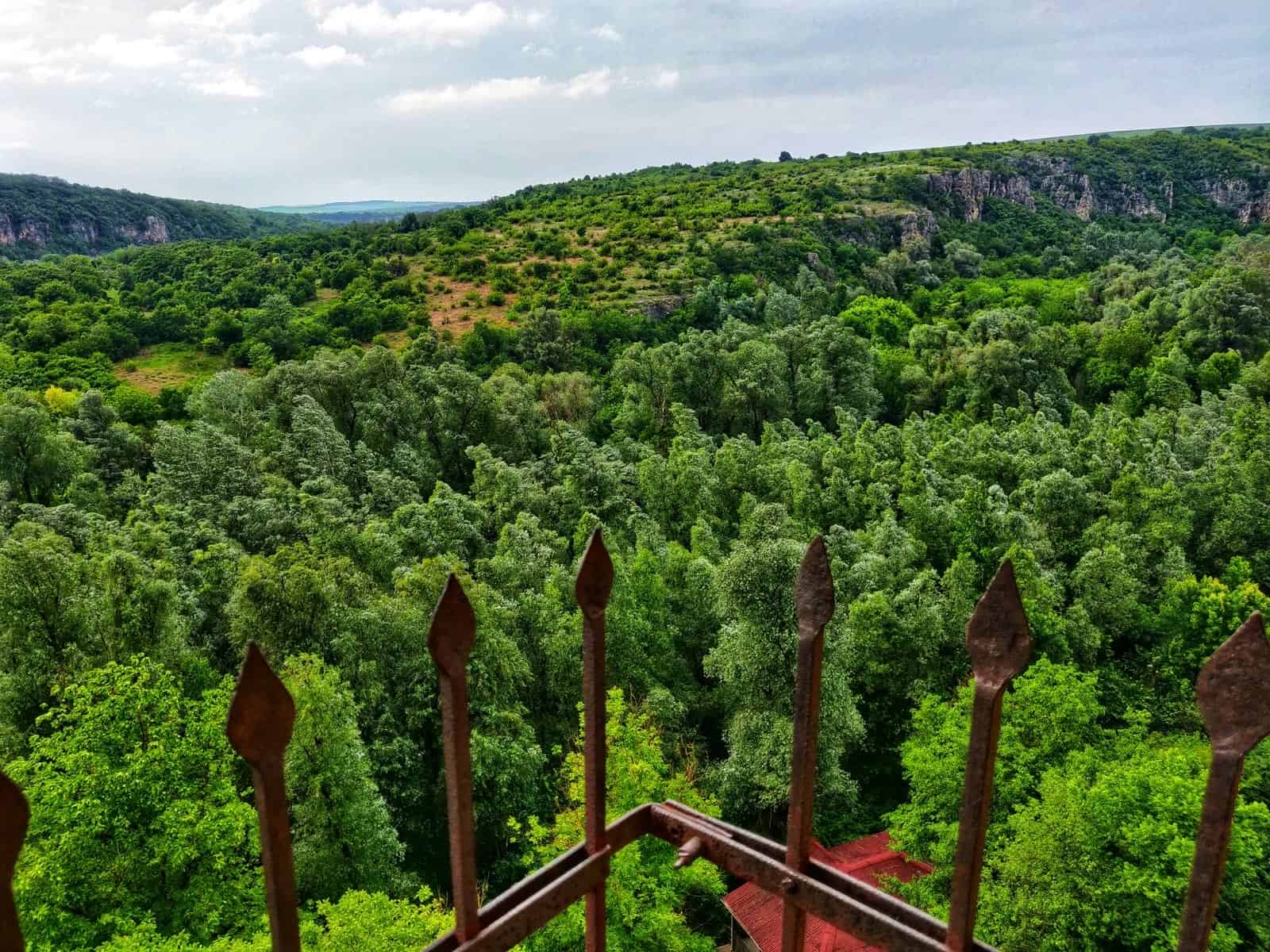
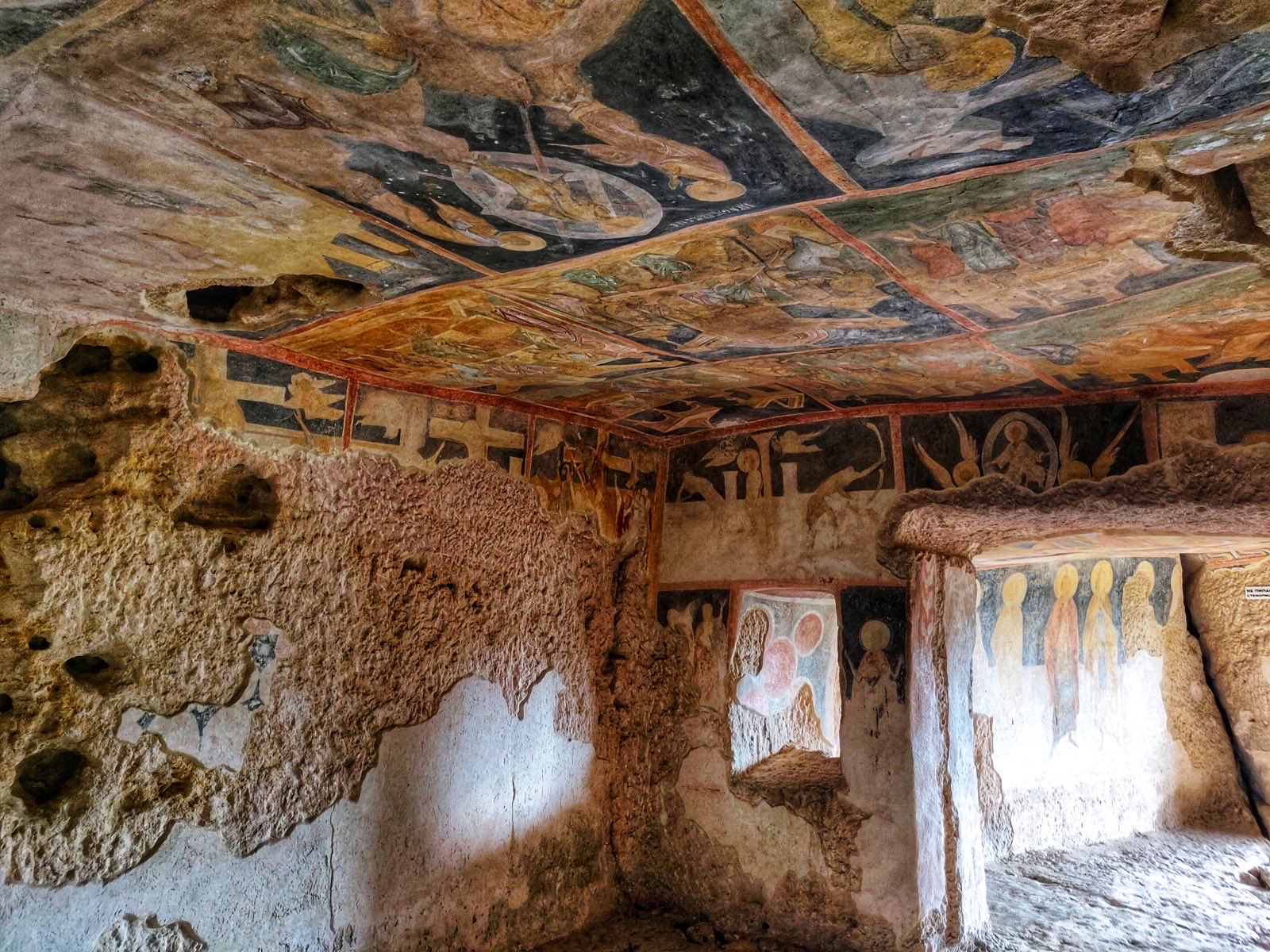
Bulgarian Fields
The following day, I walked for a bit over 2 hours from Ivanovo along the same winding, relatively quiet road that I had followed for much of yesterday. A few kilometres from my next stop, Dve Mogili, a construction van filled with freight pulled over, and the driver asked where I was headed. I tried to say that I was so close to Dve Mogili that he needn’t worry, but he continued to gesture for me to hop on. He pointed towards the open back (like a pickup truck) and I scrambled on board just as he pulled away. For five or so minutes, I rode in the back of the truck, clinging on. Every time we rounded a bend, the freight – large piles of clay tiles – threatened to fall onto me! He dropped me off by a construction site in town and tried to offer to take me further, but I insisted he’d done more than enough. I soon discovered that my knees and hands were orange-tinted from the dust off the tiles and the rust of the old frames that I had half-clung to, which held the stacks together.
Having replenished my wallet in town, and after a fuelling on a kebab, I left Dve Mogili. The rest of the day was largely filled with following that same winding B road (which was rather quiet with less traffic than yesterday, which even then was quiet), and then a bit of dual carriageway walking, before I decided to tromp through fields (the main crop was some sort of root vegetable, with thousands of grassy stalks poking out of the ground). The ground alternated between slow-walking soft soil, and cracked, hard earth, and I rather enjoyed my midafternoon jaunt through these Bulgarian fields. The early part of the day had been cloudy and the heat kept at bay, but for the remains of the walking day, the clouds lifted and a mid-20s heat settled in, complete with sun rays which were becalmed in comparison to the last four days or so.
It was after this stretch of trans-field walking that I arrived in Byala, which I passed through, arriving at a roadside motel on the west of town where I enquired and accepted a room. After stripping off in the room and setting my sweat-drenched walking clothes aside, I settled down for the night. Despite the road nearby, the bird song was stronger still as I relaxed and melted into the warmth of the early evening.
Veliko Tărnovo
Faint wisps of clouds streaked across the ether the following morning, but in general, the sky was rich blue and the sun took up its post on high, gleaming down. After the morning of mid-20s, the temperature soon rose to 29 °C, then into the 30s.

By the midafternoon, my feet, used to their own rhythm, led me into the city of Veliko Tarnovo. I had done some research and booked a hostel for a few nights in the very centre of town. I’d found myself craving some city time and the urban lifestyle once again — filled with coffee houses and history lessons. Passing the monument to the Assen Dynasty, I then crossed the bridge and ascended the terraced hillside into the old town.
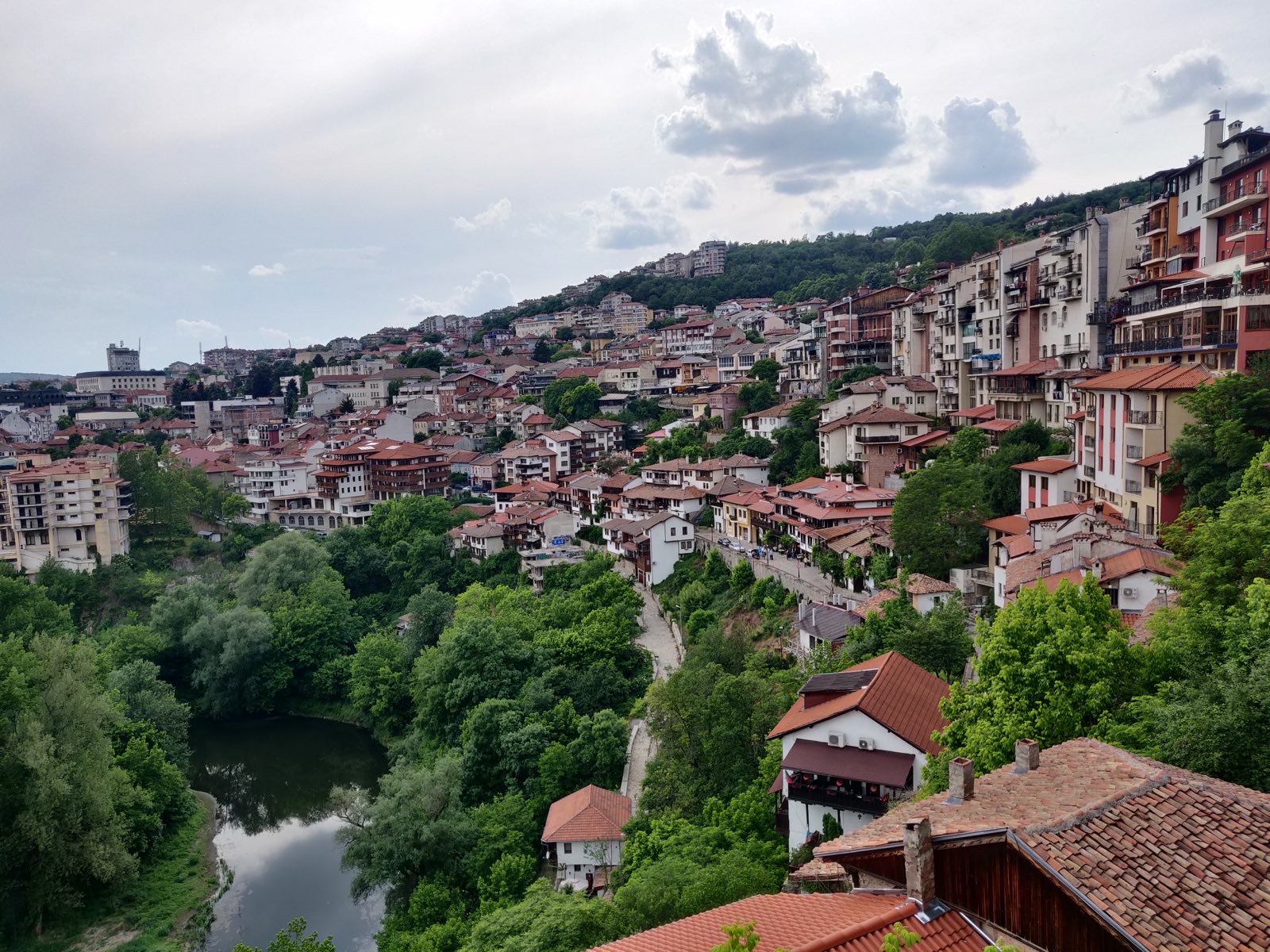
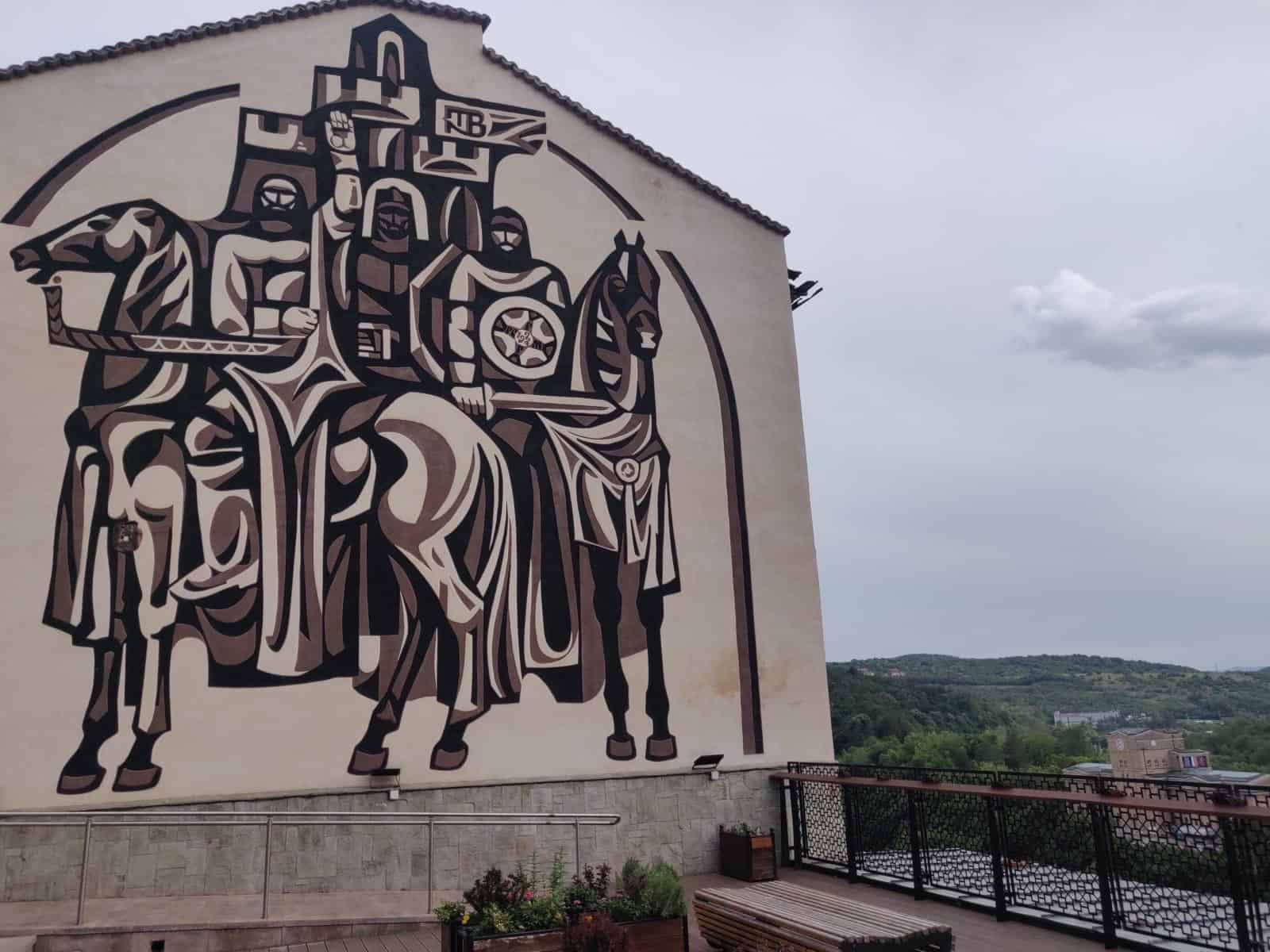
The heat had become an inexorable factor of the walk over the past couple of weeks. And whilst my brother’s struggles had really opened my eyes to how hard walking had become, in Bulgaria there was now an added weight of humidity; even the more mild days were hot and heavy. My light t-shirts and sportswear regularly found themselves in a sodden heap on the floor come the end of the day.
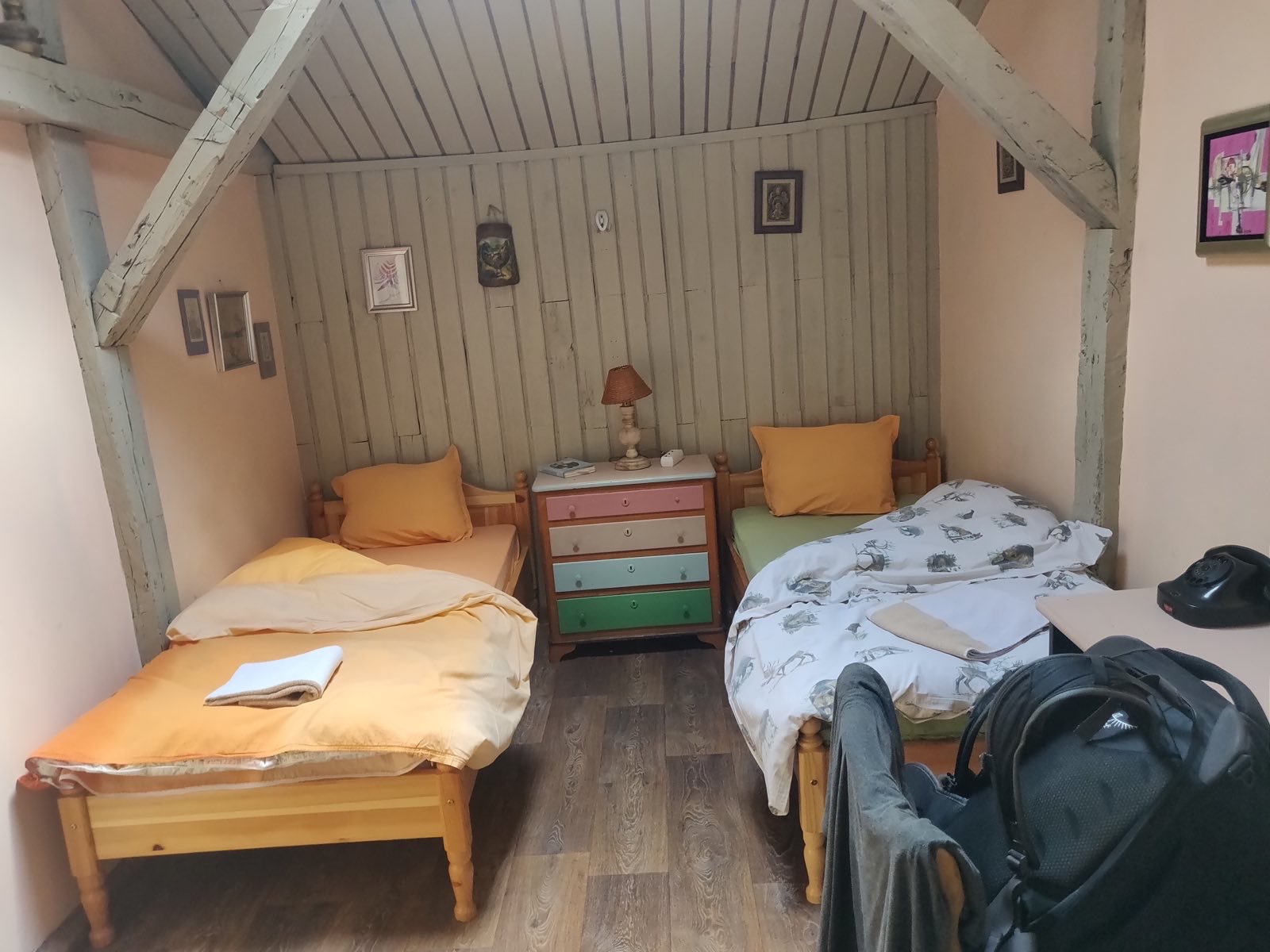
That evening, emerging from a bar on the hillside, a wind suddenly began to blow with freakish intensity, and white flashes above soon lit up the night sky so brightly that one could make out the wary expressions behind panes hundreds of meters away. A great storm was brewing.
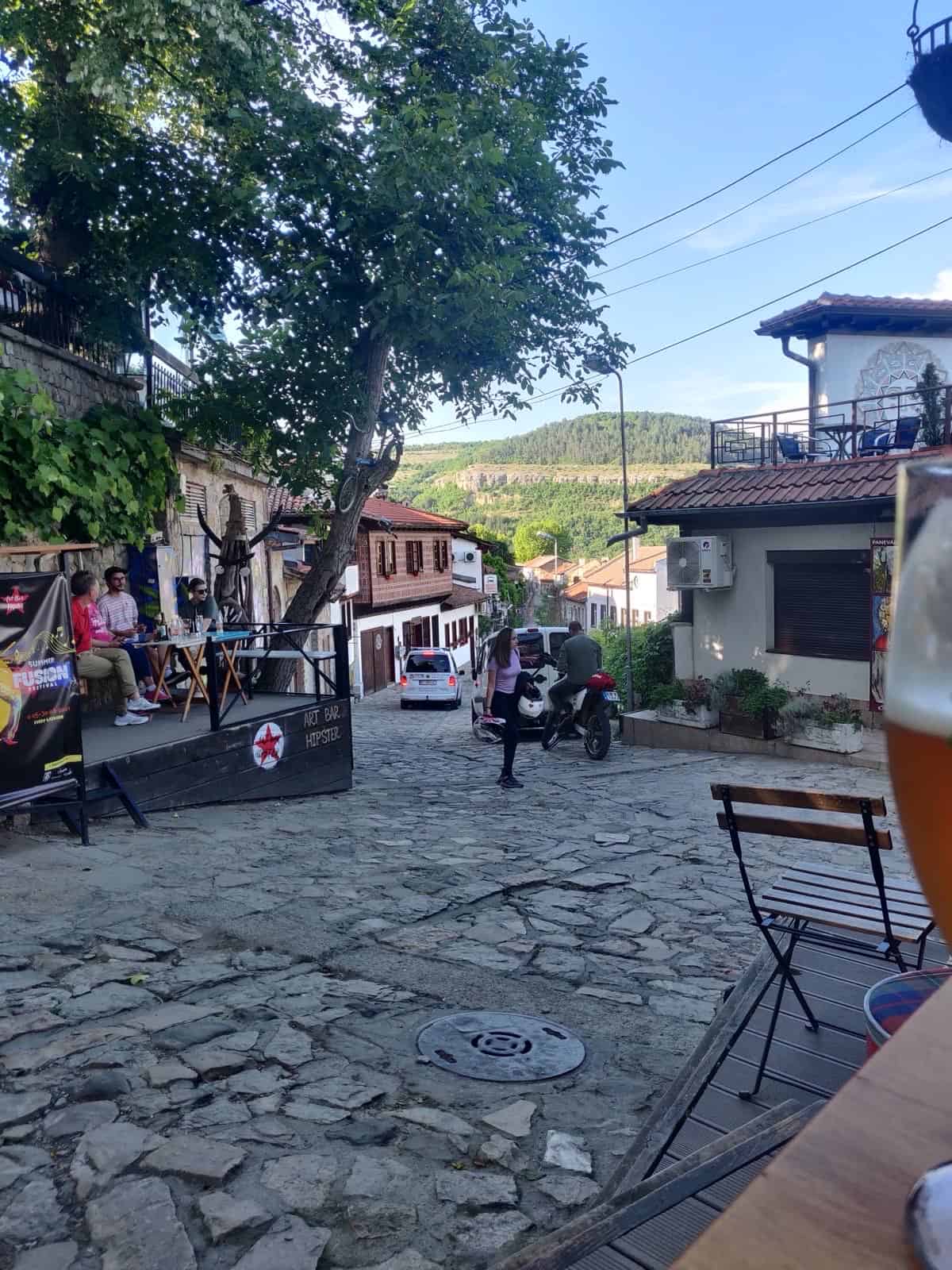
Tsarevets
No sign of the night’s freakish weather remained come the morning, and I left my hostel to find a group of five or so young university artists sprawled out along the steep gradient of the cobbled alley just outside. Their easels, bearing the black chalk of initial sketches, were tucked expertly between the nooks of the irregular stone cobbles underfoot.
I immediately headed to the site of Tsarevets, just to the west of town. En route, the city fell away, revealing the makeup of the valley around. I realised I hadn’t quite appreciated the structure and stark layout of the town the night before; Veliko Tarnovo sprawls over the ridges of several hills, which intersect and meld into one another. The old town – the Varusha Quarter – is in the east of town, and the city stretches out west and south. But east of Varusha, there is the gem of a ruined citadel: Tsarevets. An undulating hilltop fortress lies surrounded down below by the meandering Yantra river, which all but encircles the hill on which it rests. Tsar Petur, seeing the strategic advantage of the site and its previous 5,000-year history, made it his capital – the capital of the Second Bulgarian Kingdom – a bulwark of the empire until the Ottomans reduced the kingdom and the palatial fortress to rubble.
Yet more art students were sprawled along the edges of the ridge in secluded side alleys, setting down the splendour; they have been permanent fixtures of the town — the views and higgledy-piggledy streets indubitably lend themselves to the practice. If only I could draw; I’m left with word-pictures — and that is no bad thing.

With my ticket secured, I crossed the stone bridge towards the site, passing hosts of tour groups, couples, and school trips. From the bridge are stunning views all around of the meandering river and city, and up into the fortress. Through the main gate, the craggy and terraced nature of the site is obvious, and kids climbed up and down the rubble of the 12th and 13th century buildings. Whilst very little of the great site (some 400 buildings and 22 churches originally) has been restored, the rubble and walls that remain paint a stark picture of medieval dominance. I ascended to the Patriarchate Church, a 13th Century building at the very top of the site. The chanting within was moving — a service was in progress. Scratching around at the entryway of the church, I watched and listened as the robed clergy sang in beautiful, orthodox harmonies. The interiors had been restored with modernist and woebegone orthodox frescos — a disappointment till I closed my eyes and simply listened.
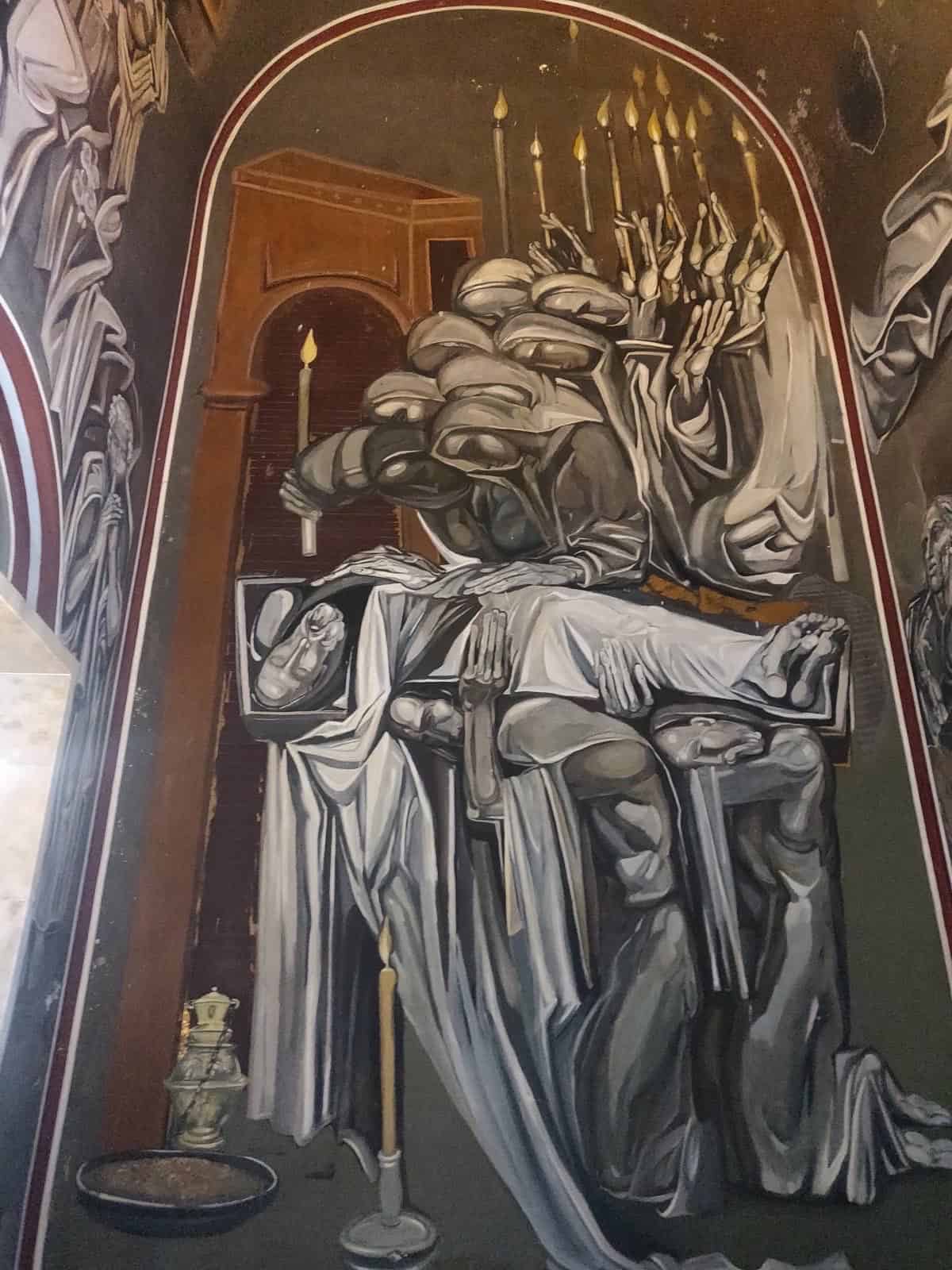
I descended from the church and service only to hear a worryingly loud klaxon sound its ominous tone across the valley for 10 straight minutes. Soon this was forgotten and, after taking in the view from the stone turret of Baldwin’s Tower, I headed back into town, absolutely drenched from the heat and the mild hike.
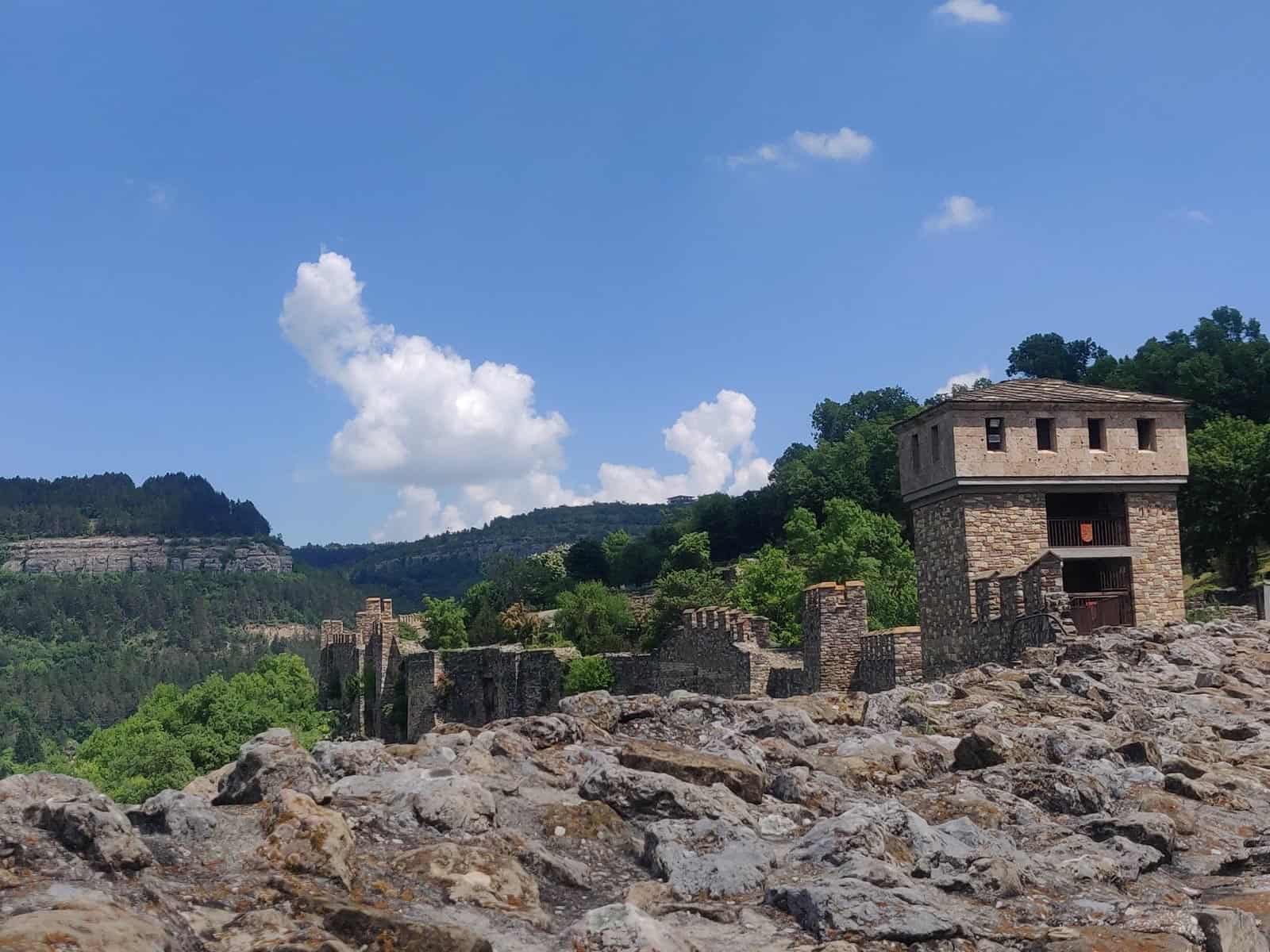

Monastic lodgings in the woods
I departed Veliko Tarnovo a few days later and spent that day walking through sections of the (relatively recently established) Bulgarka Nature Park and its northern approaches. (The park itself had been described to me vaguely as occupying the central and eastern part of the mountains between the cities of Gabrovo and Kazanluk.)

Around 4pm, I drew up at Dryanovo Monastery, my destination for the night. I walked through the stone complex and into the quaint church, past a young monk sat on the steps outside. The walls and roof within displayed the charming orthodox paintings of which I had already become so fond! An amusing element of such Orthodox spaces – churches and cathedrals great and small – is that it really always feels as if there is a service going on: there is always a cantor chanting, incense burning, and, somewhere, a priest doling out his blessings to the faithful.

On the whole, the monastic site was small, but spread out. There was not really all too much to it on a structural level — a small church and lots of two-story timber buildings; however, it was the setting that inspired, the charm of the place, all set against a backdrop of cliffs and steep forest. Non-Bulgarian information was scarce, but how populated the monastery still was remained to be seen; although not an insubstantial tourist-sight – the number of trinket sellers outside paid testament to that – there was not in reality much of note going on. But then again, rambling buildings set amongst the surrounding ridges and flora, were evocative and tranquil. Occupying one of the timber buildings of the complex was an inn: I duly begged a room.

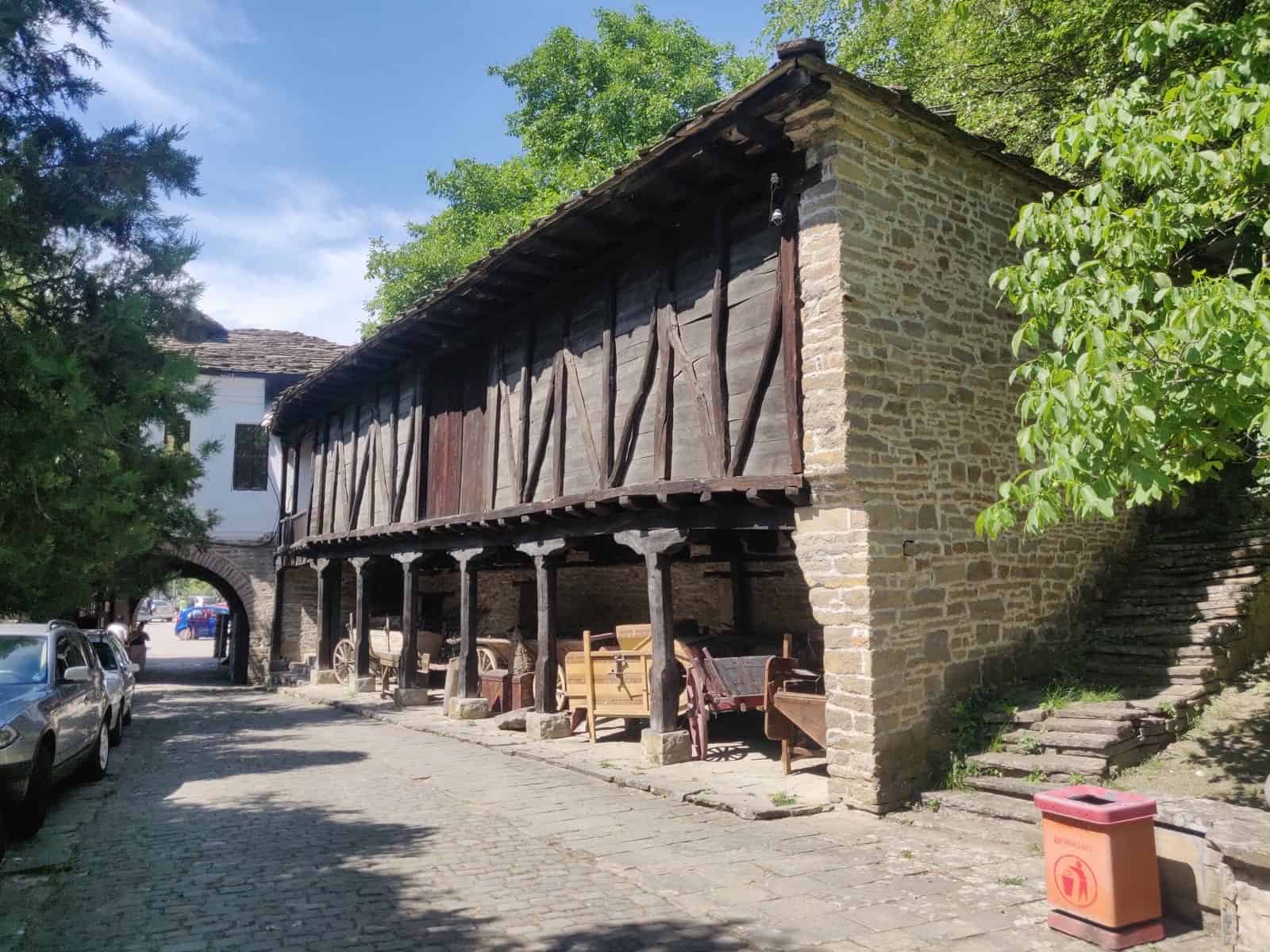
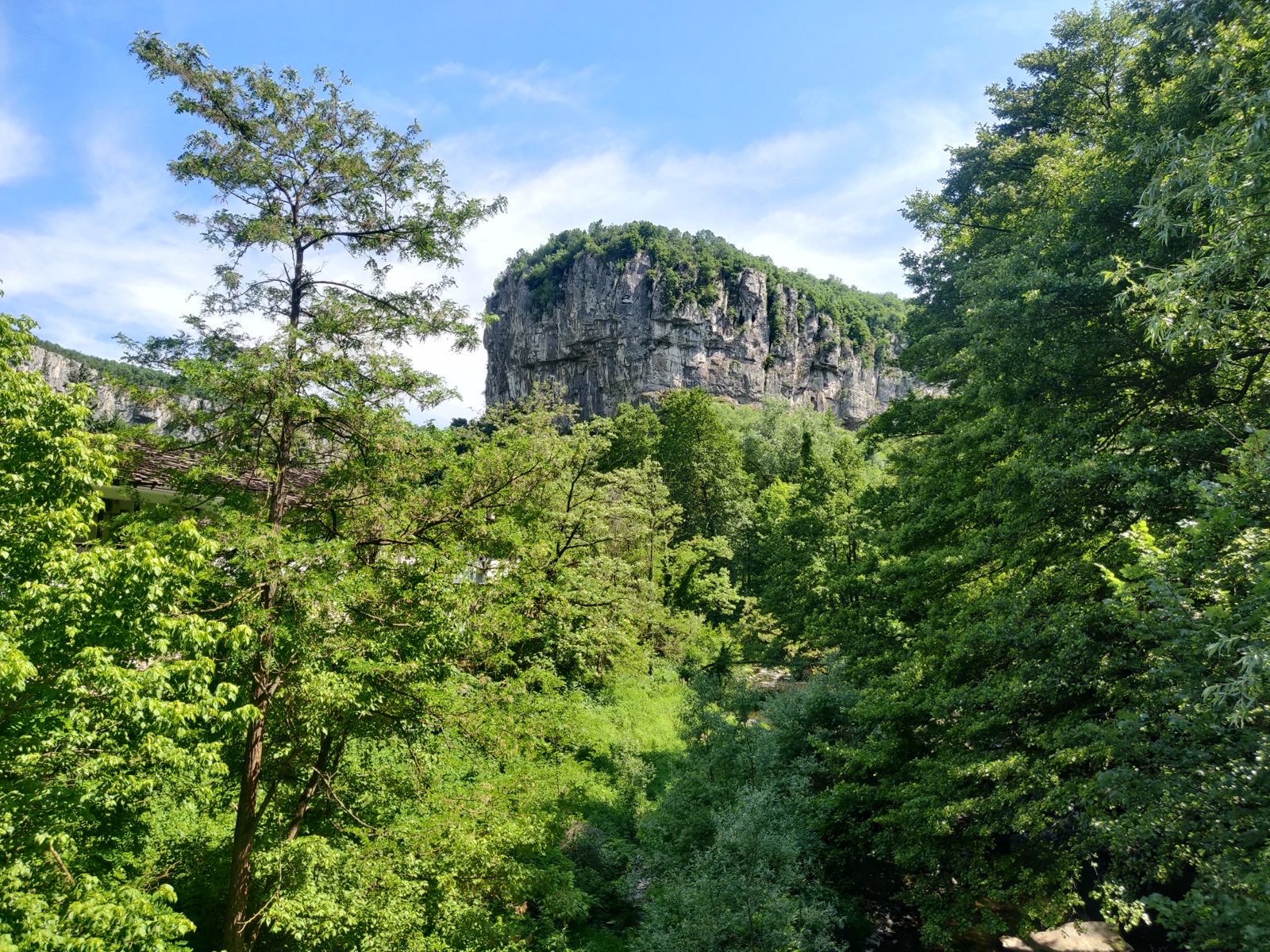
I was a sore and over-sunned secular pilgrim upon my arrival, so I headed downstairs to the tavern in the entry courtyard below my room and watched cricket (on very iffy Wi-Fi) and ordered a late lunch of Bulgarian salad to settle my stomach. Then, around 7, I headed around the rest of the complex and out the other side, over the bridge which crossed the shallow, though fast-flowing river. There was a different tavern on the other side. I had a couple of beers, a “pilgrim’s salad” of aubergine, cucumber, tomato, boiled eggs, olives and grilled peppers; followed by a small plate of “grilled chicken hearts” (the menu was hardly a work of St Jerome or Sir Richard Burton!) with fried mushrooms. The seasoning was delicious – all spiced and sautéed – and the dish was tender and surprisingly good! En route back to my room, I stopped to pet the lone pony pacing in a pen in the main in the courtyard of the monastery. He stood obdurate guard over two peacocks in an adjacent cage.

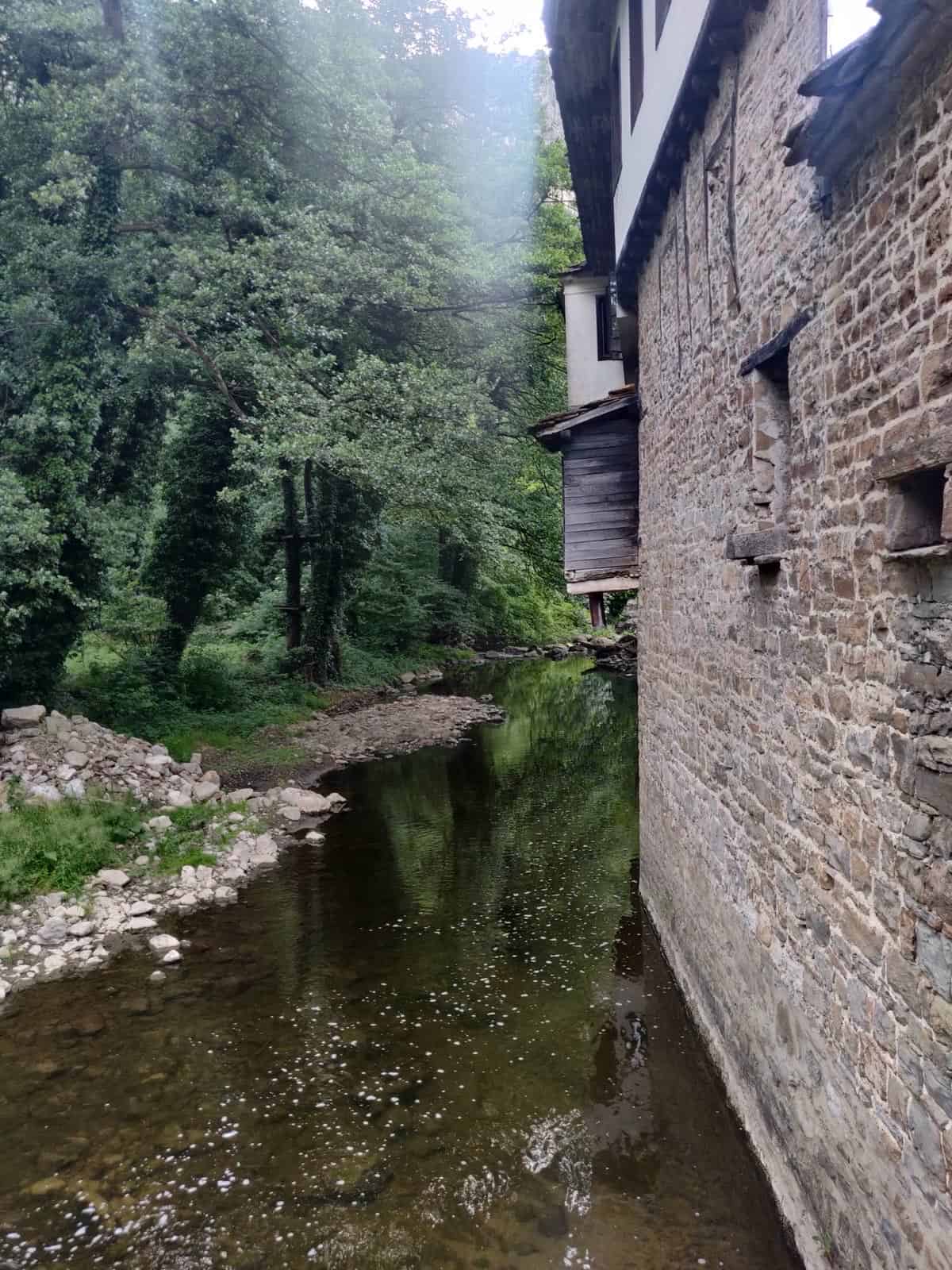
Stalagmites and stalactites
Departing the monastery early the next day, I headed through the complex and across the river to where I’d had supper last night. Following some signs, I found the path up and along the hill towards the Bacho Kiro Cave. Just before I reached it, the thunderous sound of water marked my arrival at the Dryanovo Waterfall, just off to the right. The sunlight glinted refreshingly off the cascade, as I hiked up the hot final ascent to the cave.

It was a rather jarring sight to discover a crude metal booth and fence posted at the natural cracks in the rocks: an entry fee was, of course, required, and its requirement and the kiosk’s garish appearance certainly detracted from the feeling of discovering a natural cave. That aside, and the meagre 3 Leva paid, I entered.
Information boards at the mouth of the cave claimed this to be the home of the earliest traces of human life in not only Bulgaria, but the entirety of South-East Europe, too: once home to Neanderthals of the late-Palaeolithic age. Inside, a long gallery stretched back up and into the rock a kilometre or so. The cool of the cave struck me immediately. The automatic lights dotted randomly around the galleries turned off and on a whim, leaving me in the dark on occasion, as I ducked under low beams of rock and attempted to follow the rough path laid out. Climbing up through the rocks, further into the hollow crannies, a host of stalagmites and stalactites soon appeared in the so-called “Rain Hall” and “Concert Hall”. Water dripped down, lending a soothing ambience to the gloom as they hit the stone underfoot, echoing around the chambers and nooks.
A shorter day, filled with the misadventure that is constant road-side walking, reached its close with my arrival in Gabrovo. I was drenched in the sweat begotten by the heat of the day. “It’s 31 °C”, the pension owner exclaimed when I said I was on foot, not driving. He steered me off to the outdoor shower.
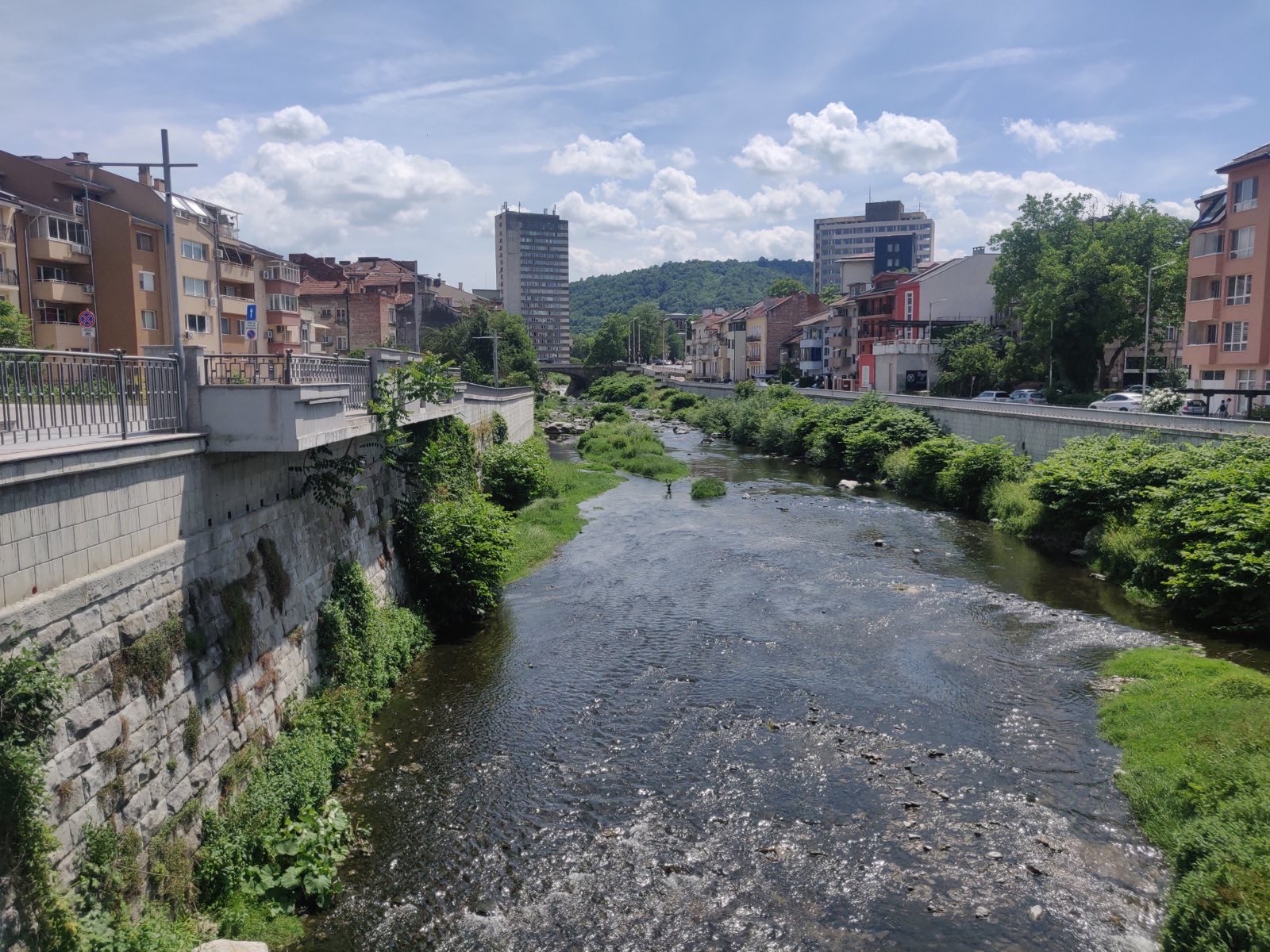
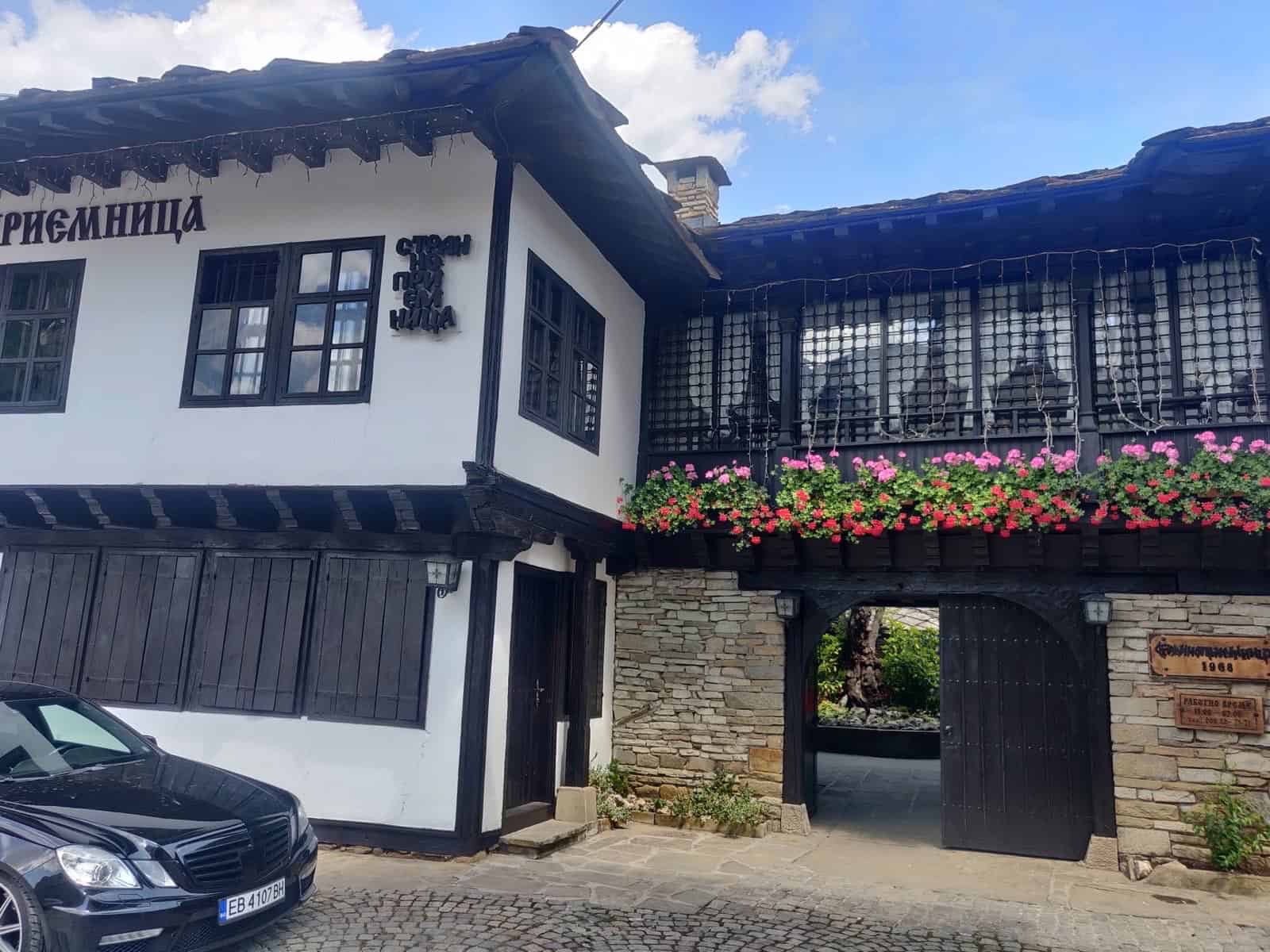
Thracian mogili
I stopped for coffee on the way out of Gabrovo. As I stood up to leave, I noticed a table near me had cracked open a bottle of local white wine. It was 9am.
A man I had run into at a bar a week or so ago had told me a joke (or at least I took it as one): if you have four beers with lunch in the West, then you’re an alcoholic. If you do the same in Bulgaria, then you’re a taxi driver.
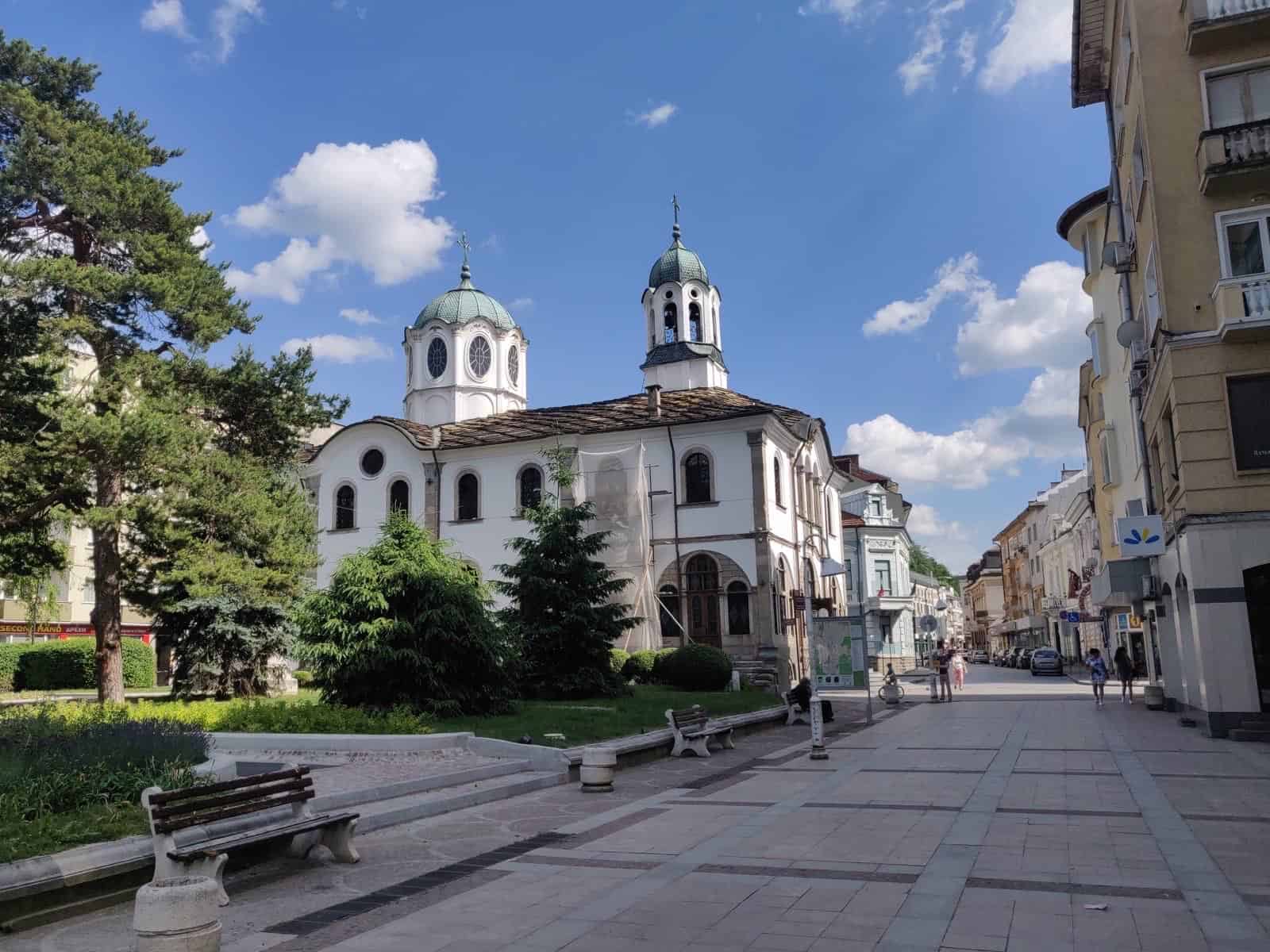
Passing by Tundzha Valley, the Valley of the Thracian Kings, I arrived that evening in Kazanlak. The town is also known by the Greek name Seuthopolis, in homage to the ancient Thracian city a few miles away. This was the first of a string of villages, towns, rivers, and cities, which all held Greek names as well as Bulgarian, if one looked closely enough; the German and Hungarian nomenclature of towns and cities across Romania had by now fallen away. I was firmly planted in a new liminal space.
Kazanlak’s Rose Festival had, by happy fluke, occurred the day before, and the guesthouse owner encouraged me to head into town: the remnants of the festivities were still all about. The Rose Festival, which honours spring, flowers, and the supple fragrance of the precious Kazanlak rose and the beauty of flowers, is one of Bulgaria’s most notable celebrations. A “Rose Girl” is selected every year and is supposably the prettiest girl in the village; it really does sound like something out of a Greek myth that provokes the wrath of a god. That or a Disney Channel high school flick. In the central square, a stage had been erected — no doubt whereon this year’s perfume princess had been deified. Or at least crowned.
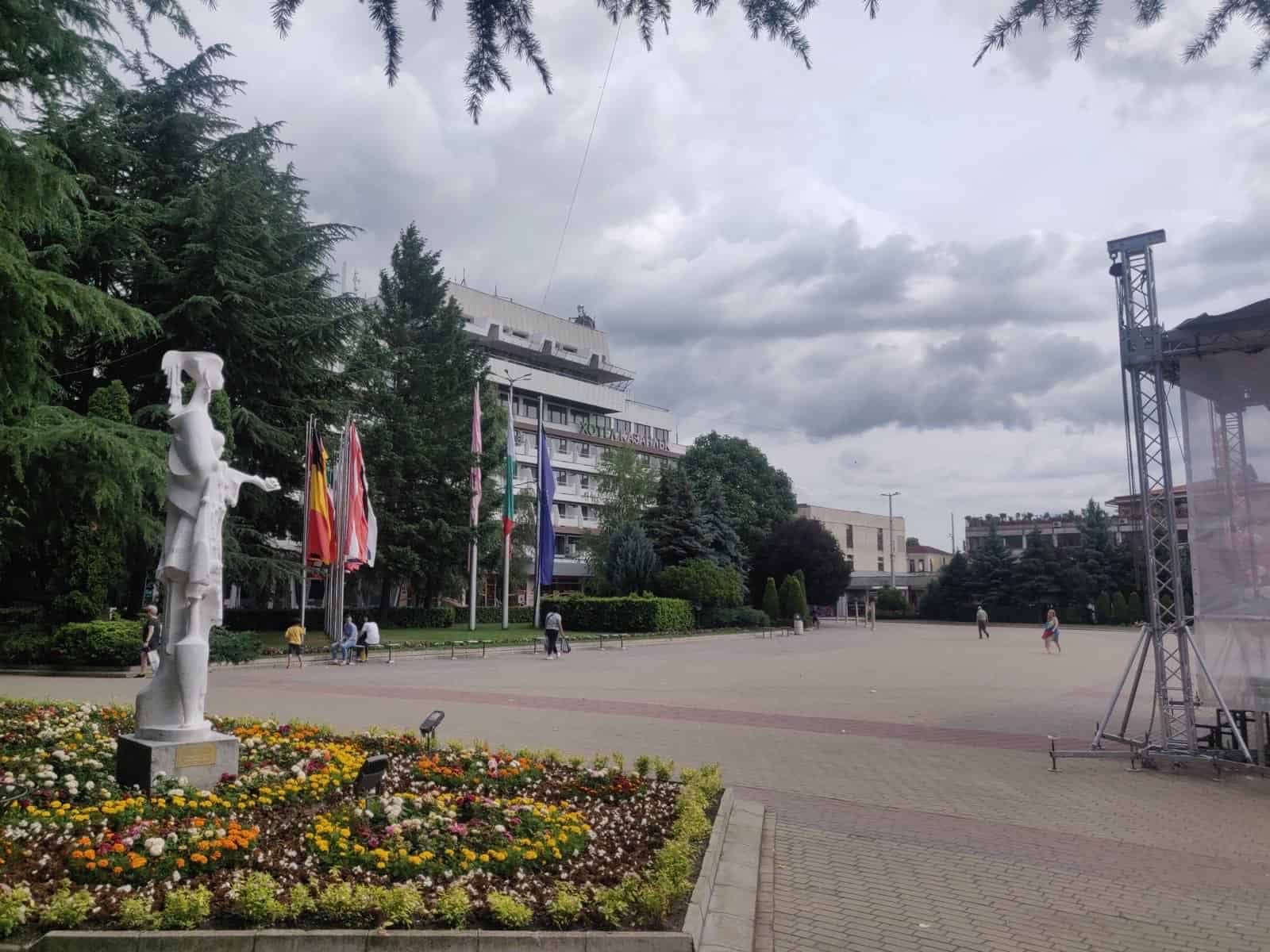
Upset that I had missed so many of the Thracian tombs in the Valley, I was happy to discover that Kazanlak was home to possibly the most important surviving tomb, despite having been raided in ancient times. Dating from the 4th century BC, it was designated a UNESCO World Heritage Site in 1979. The original tomb itself is closed off from visitors, but there was a true-to-size replica that one can enter.

Squeezing into the recreation, the pre-grave chamber was rectangular, with sloped vaulting forming the ceiling. The walls were covered in fading, yet perfectly discernible frescoes depicting battle scenes along the plastered sloped vaulting, with thin friezes above.
Through the low entryway, I ducked into the main compartment. Along the low dome of the chamber, a circular mural had been painted in a characteristically sanguine palette, depicting a procession of undoubtedly Hellenic figures: a funeral feast, the information board outside revealed.
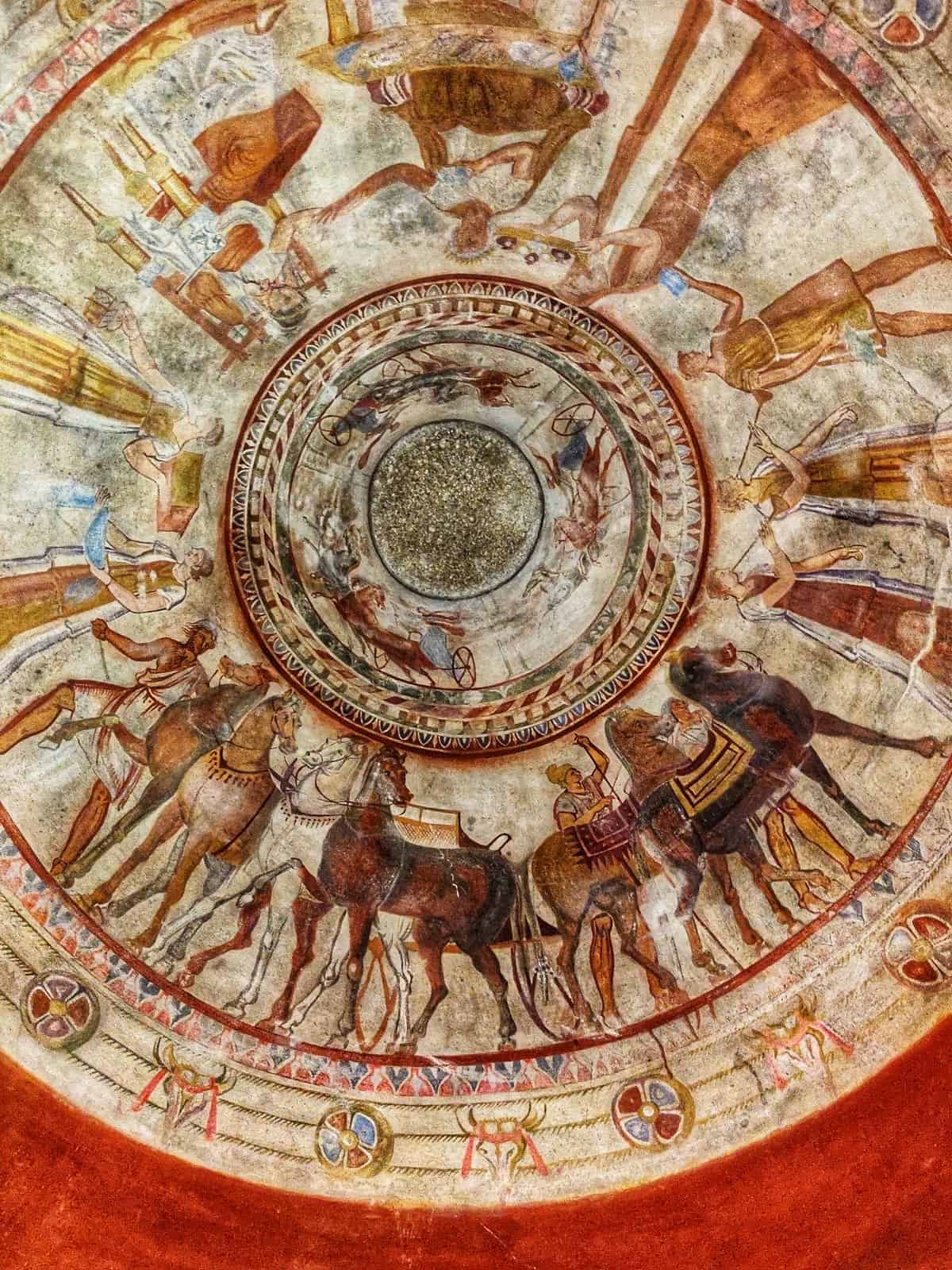
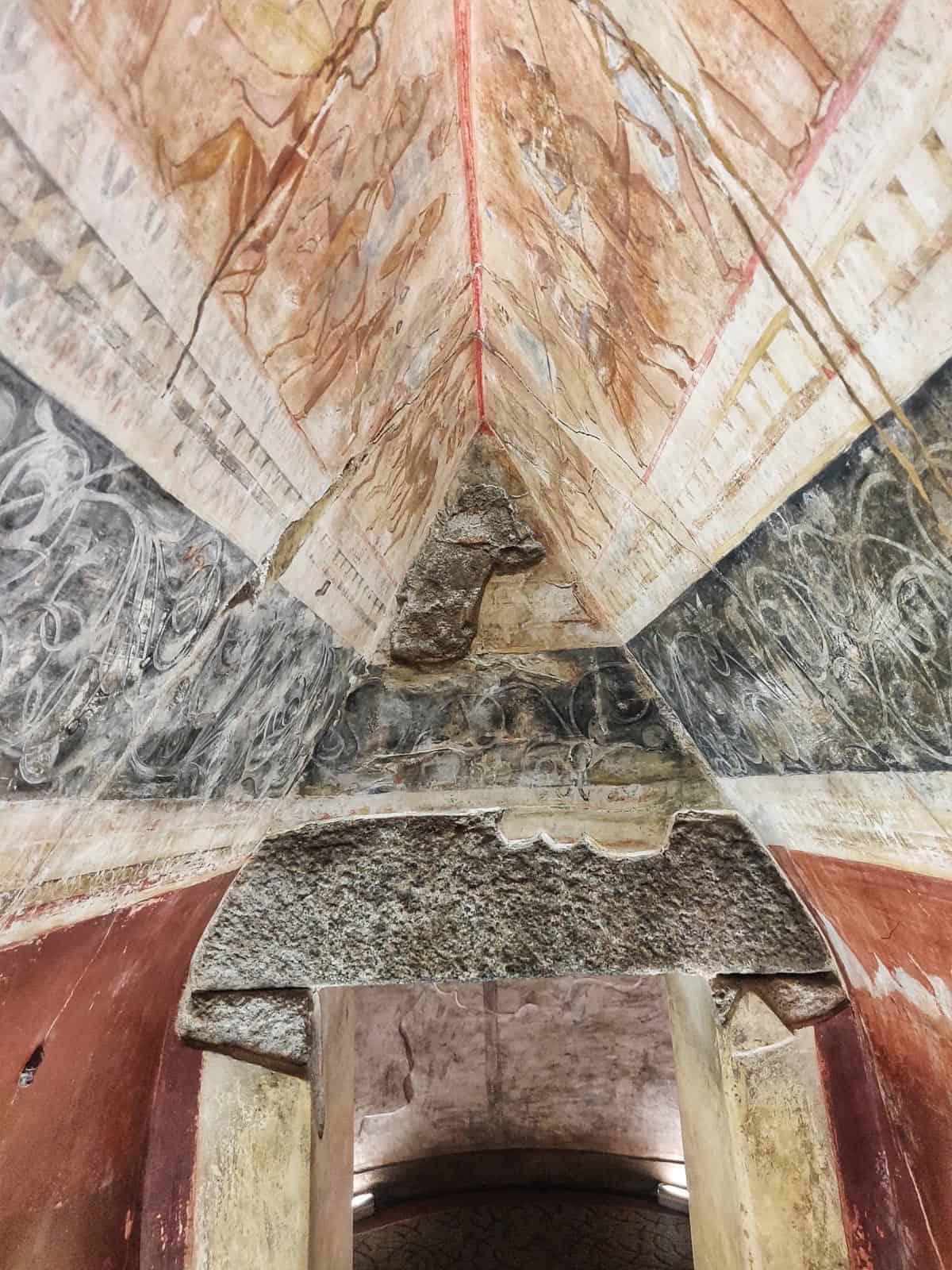
The views of the mountains to the north were captivating in the evening sun. The flora felt much more Mediterranean now; the sight and smell of pines scented the air around the tomb site. Relaxing into the evening on a balcony in my hotel in the south of town, I received a feline visitor, with whiskers to rival my own.
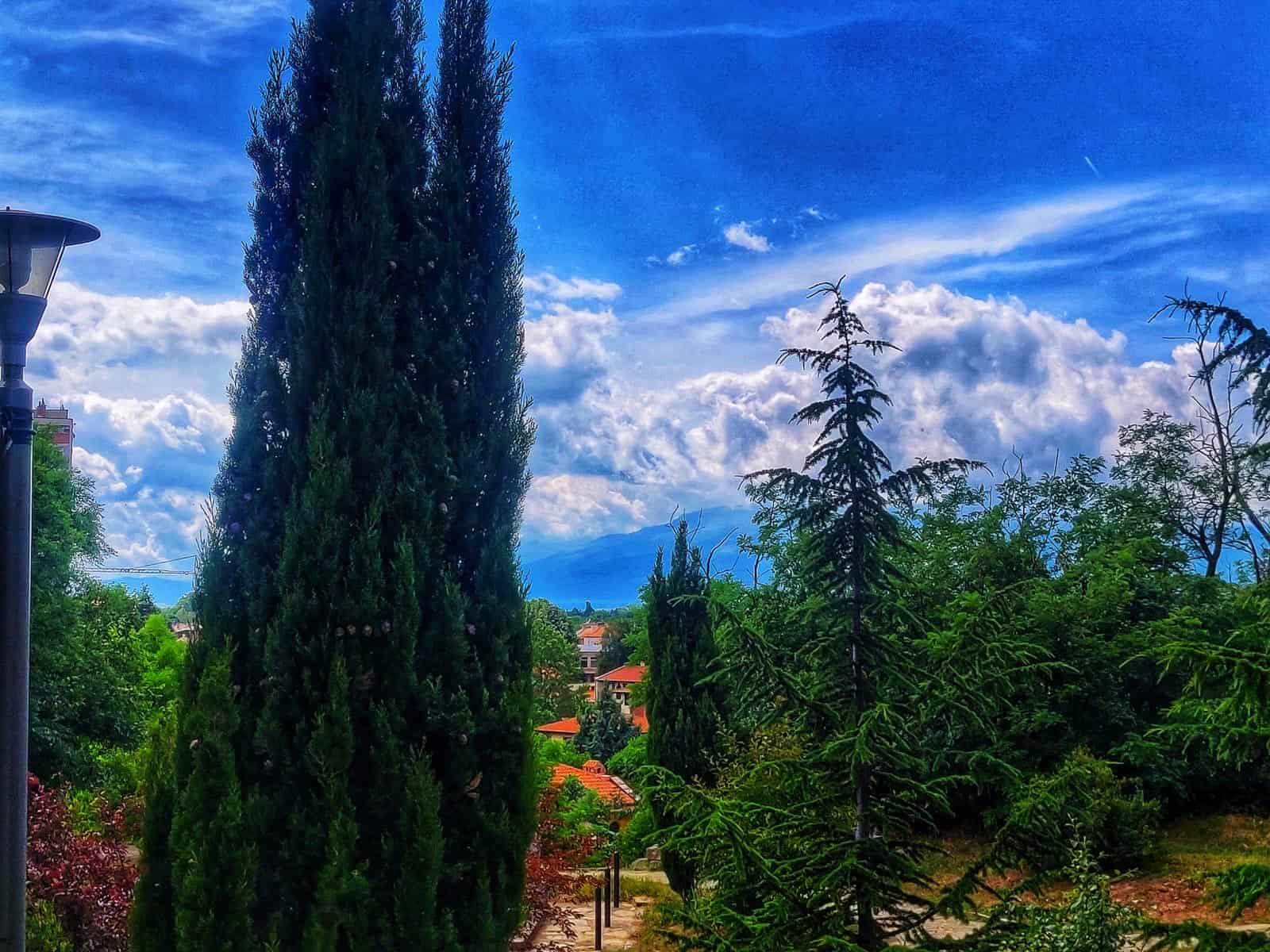
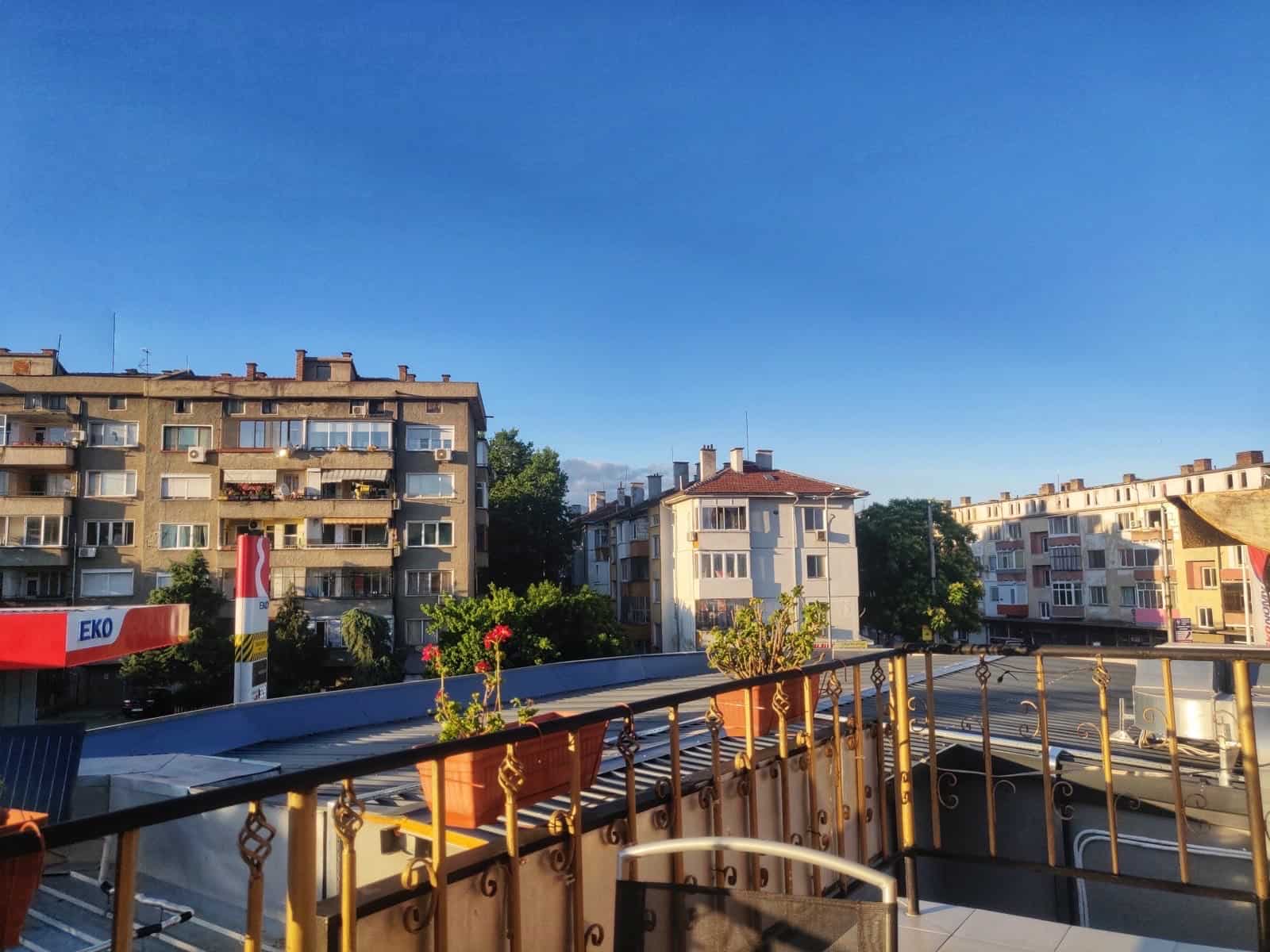
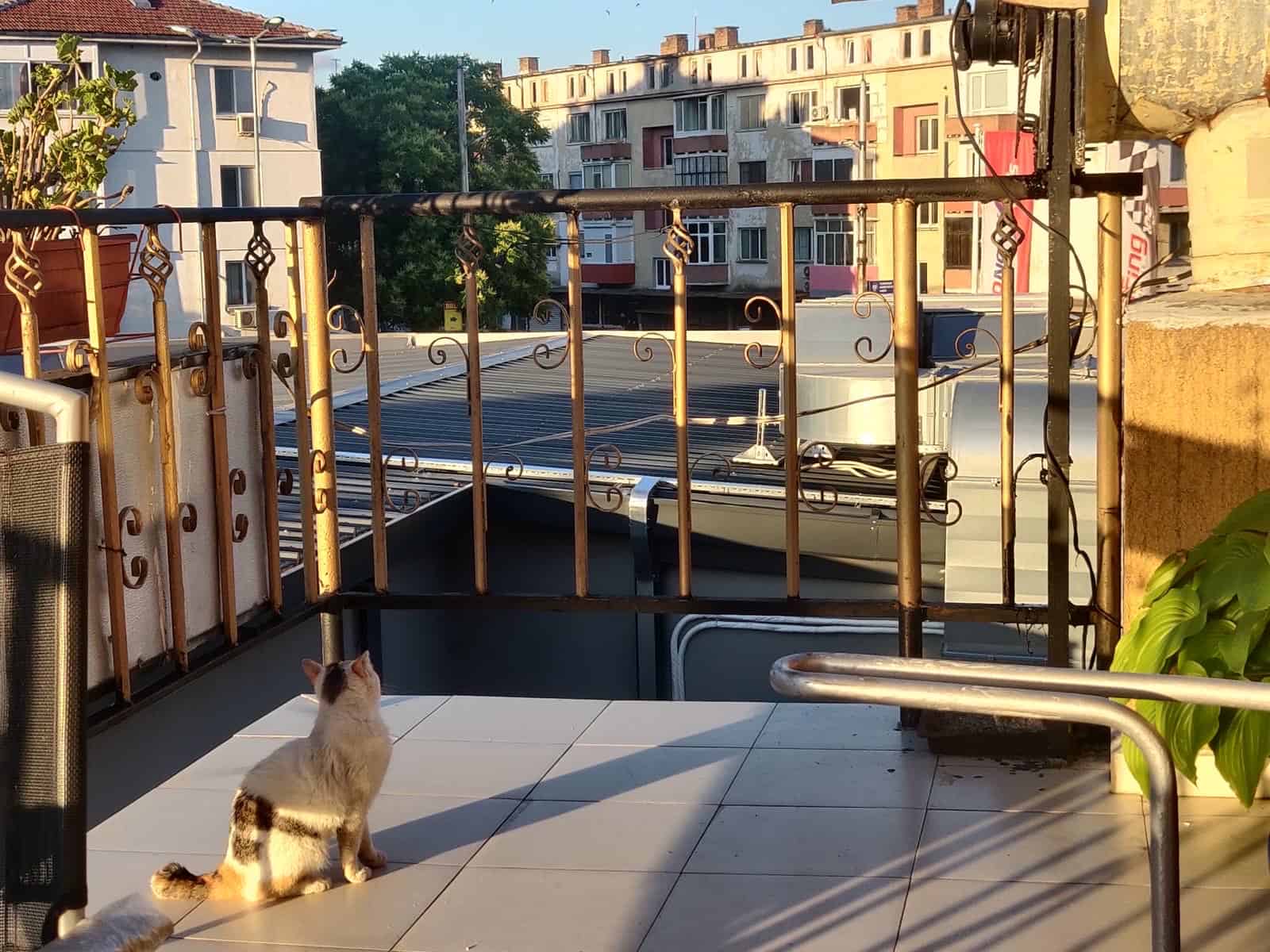
Botev’s Kalofer
The Central Balkan Mountains lay some 8 miles to the north, as I walked the following day, and as I passed Manolovo, they soon lay half-shrouded in the clouds. Smaller mountains hovered off to the south, some 25 miles away: calculating that Plovdiv lay not far from their foothills, I picked up my pace, but continued to hug the northern range as I headed west for the day. By the midafternoon, I had arrived in Kalofer.
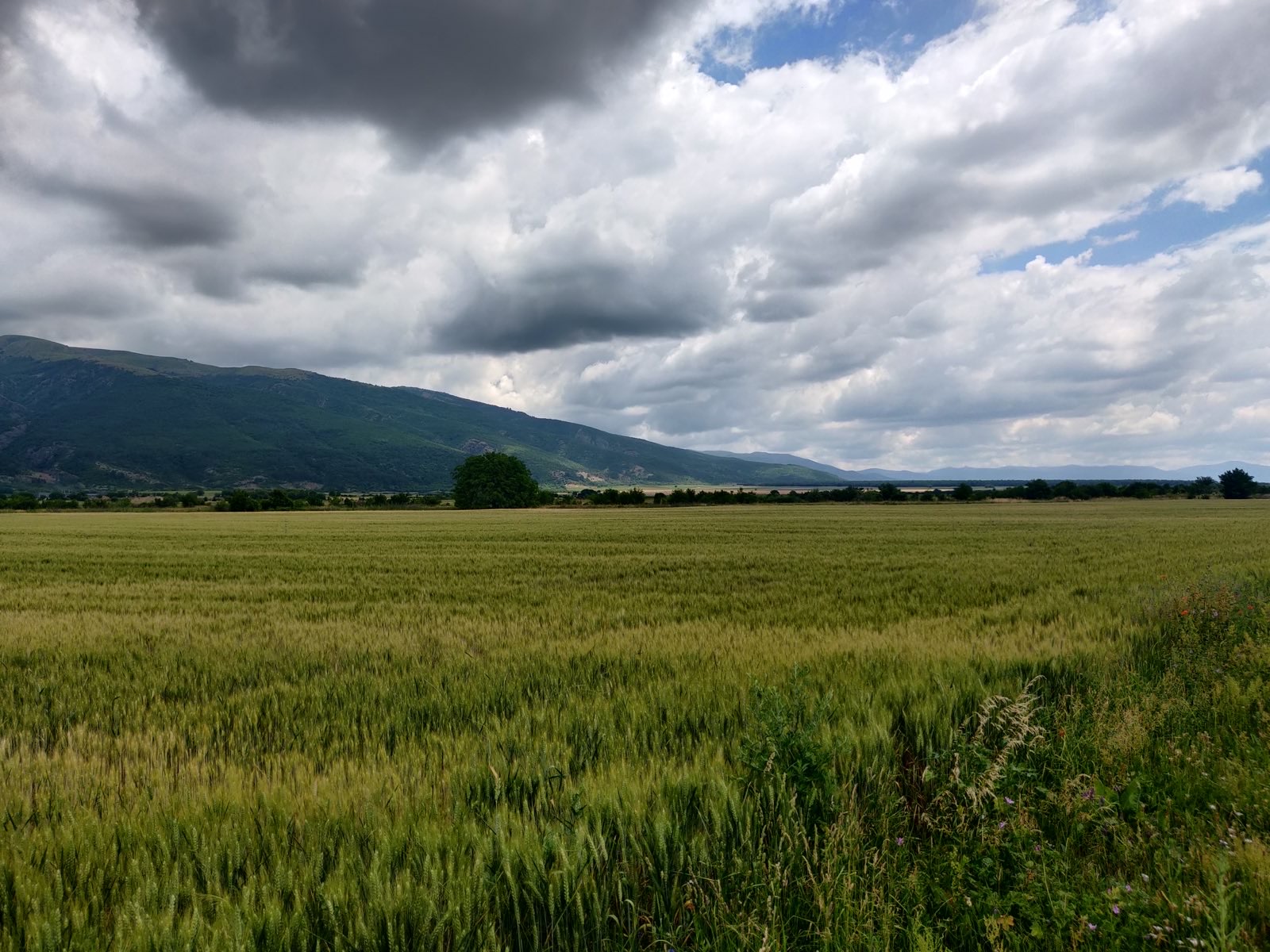

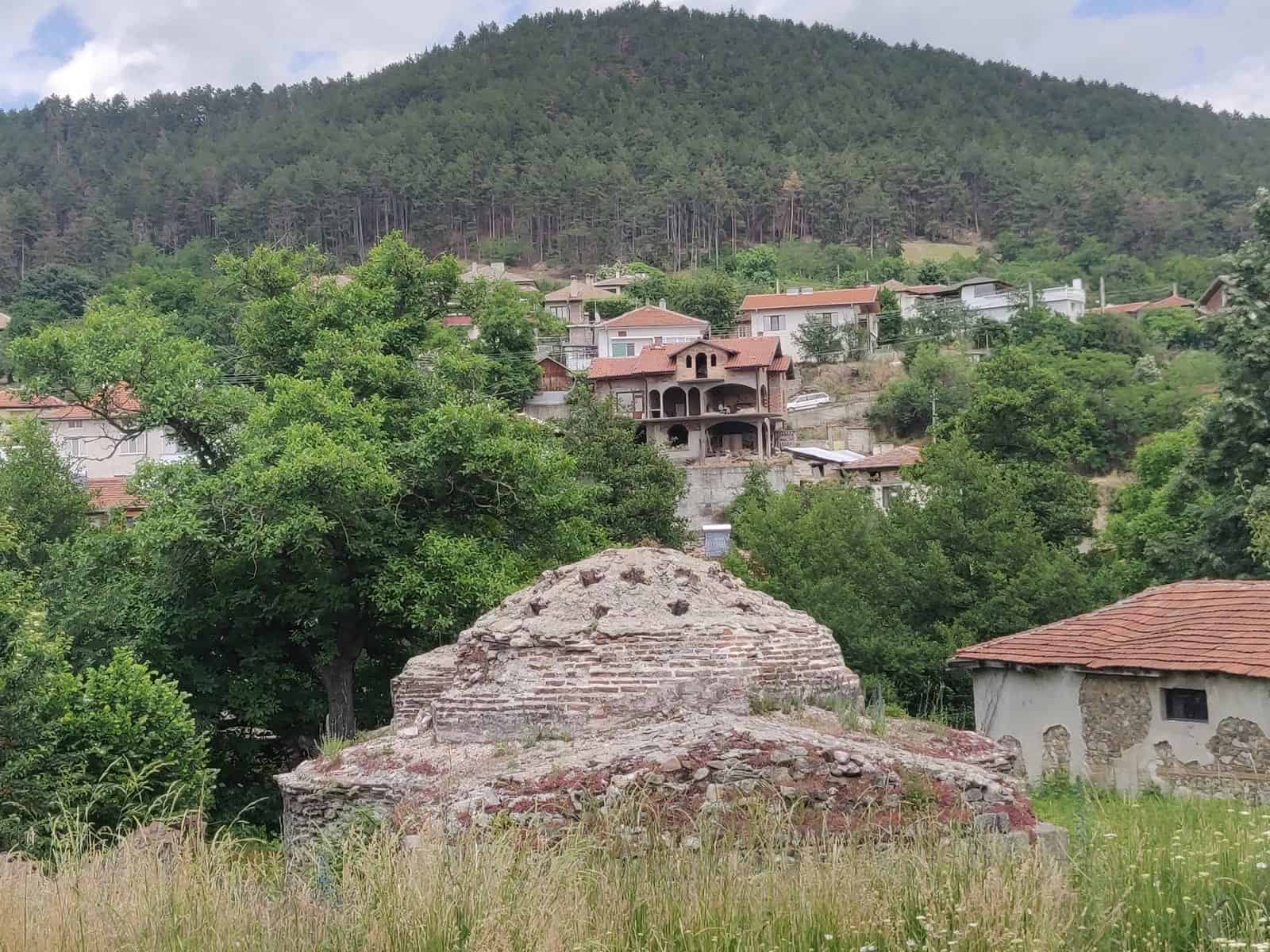
The village sits nestled in a small valley and was the birthplace of Hristo Botev, a 19th Century Bulgarian poet and national icon. He has since been memorialised in an art-deco-cum-fascist monument on the east side of the river running through the heart of town. Though I saw little modern evidence of Kalofer’s historic cord and lace production, I imagined the garb of the locals I passed to have surely been stitched and weaved in their own Kalofer style. A tour of town saw me wander through the glow of sunlight which pressed past the murky clouds to the northwest of town, up and over the mountains. The Botev moment offered a great view down stone steps, and across the clay tile roofs of town (firmly the style of the last 3 weeks or so). I reckoned the vista could be opened up further still; with a little pruning, the sheer size of the northern peaks could be further incorporated into the town (and even exacerbate the intended metaphor of the Giants of the Bulgarian National Movement so at the centre of this foothill town — a 19th Century reimagining of Bulgaria as a modern state based on an ancient one dug out from Ottoman overlordship.) Small pellets of rain began to fall. Then, a minute later, they stopped.

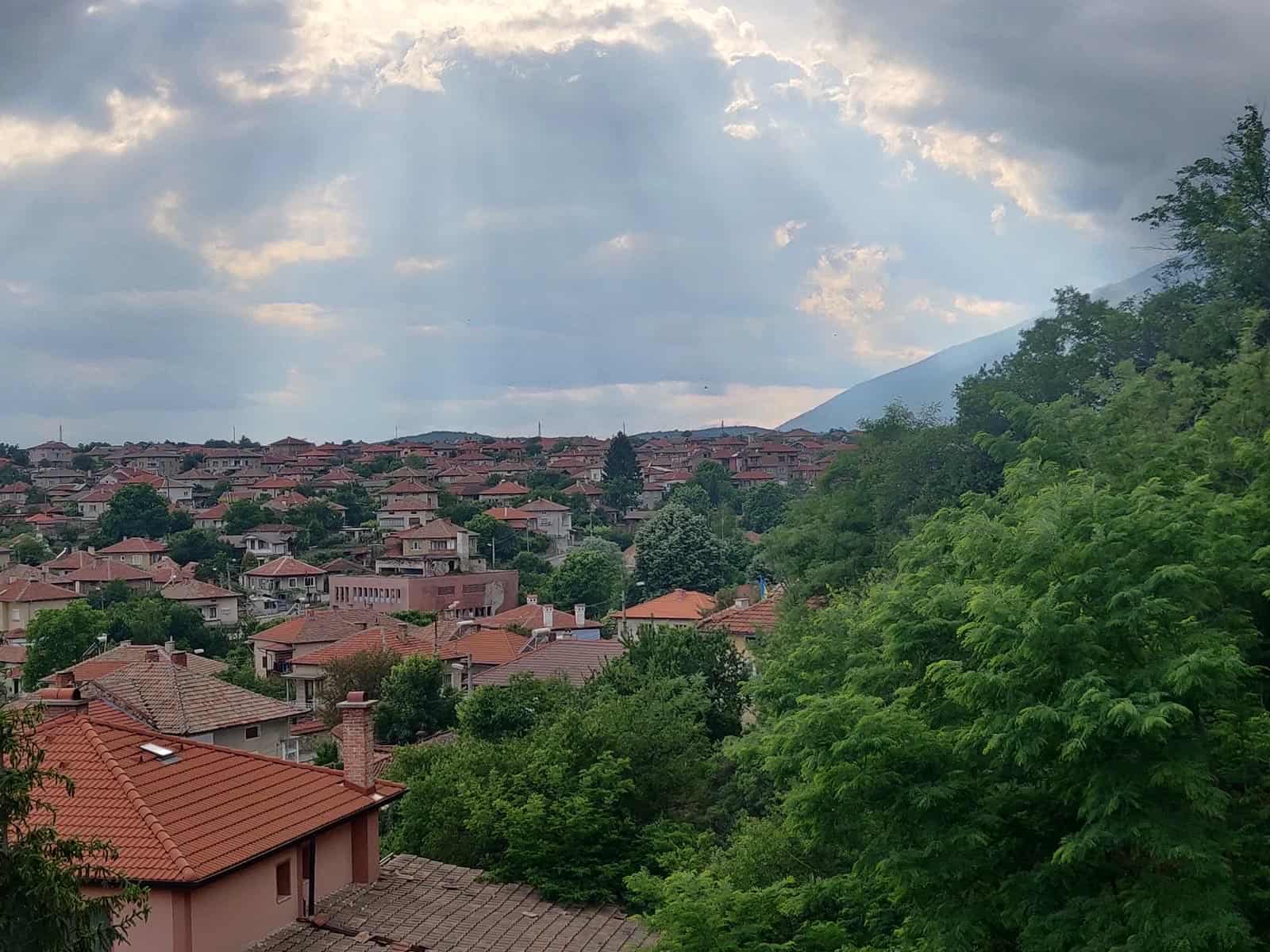
The Tundja (Tundzha) river trickled though town, fresh off the mountain. I paused by a taverna along its banks, just below a yellow painted, stone church. For supper, I ordered Yunashka salad, which arrived composed of tomato, cucumber, cheese, ham, “flat salami”, baked and spiced pepper, chillis, and spring onions. My first taste of “spicy” salads. I followed that with a plate of chicken bites with a dipping sauce not dissimilar to blue cheese.
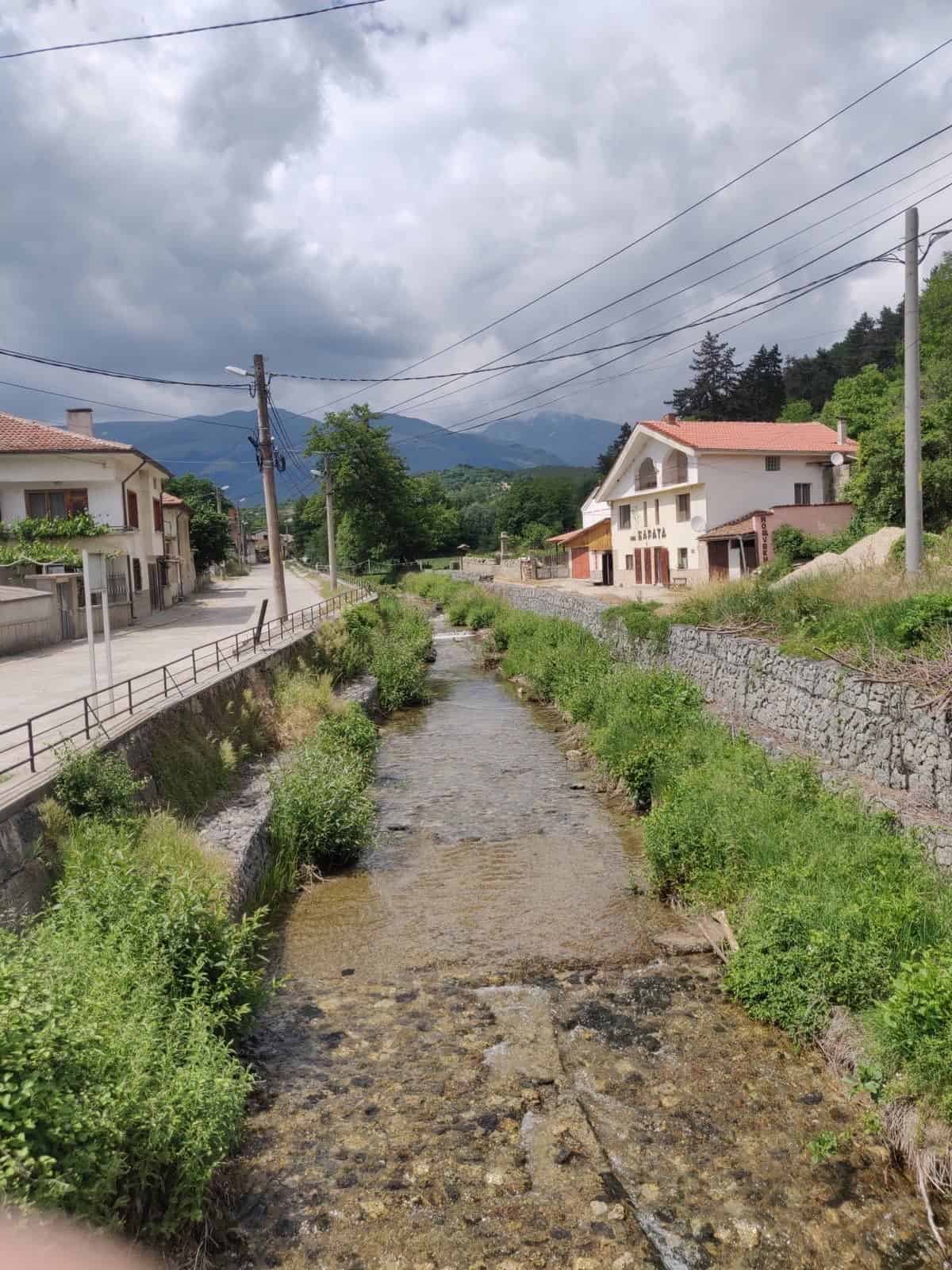
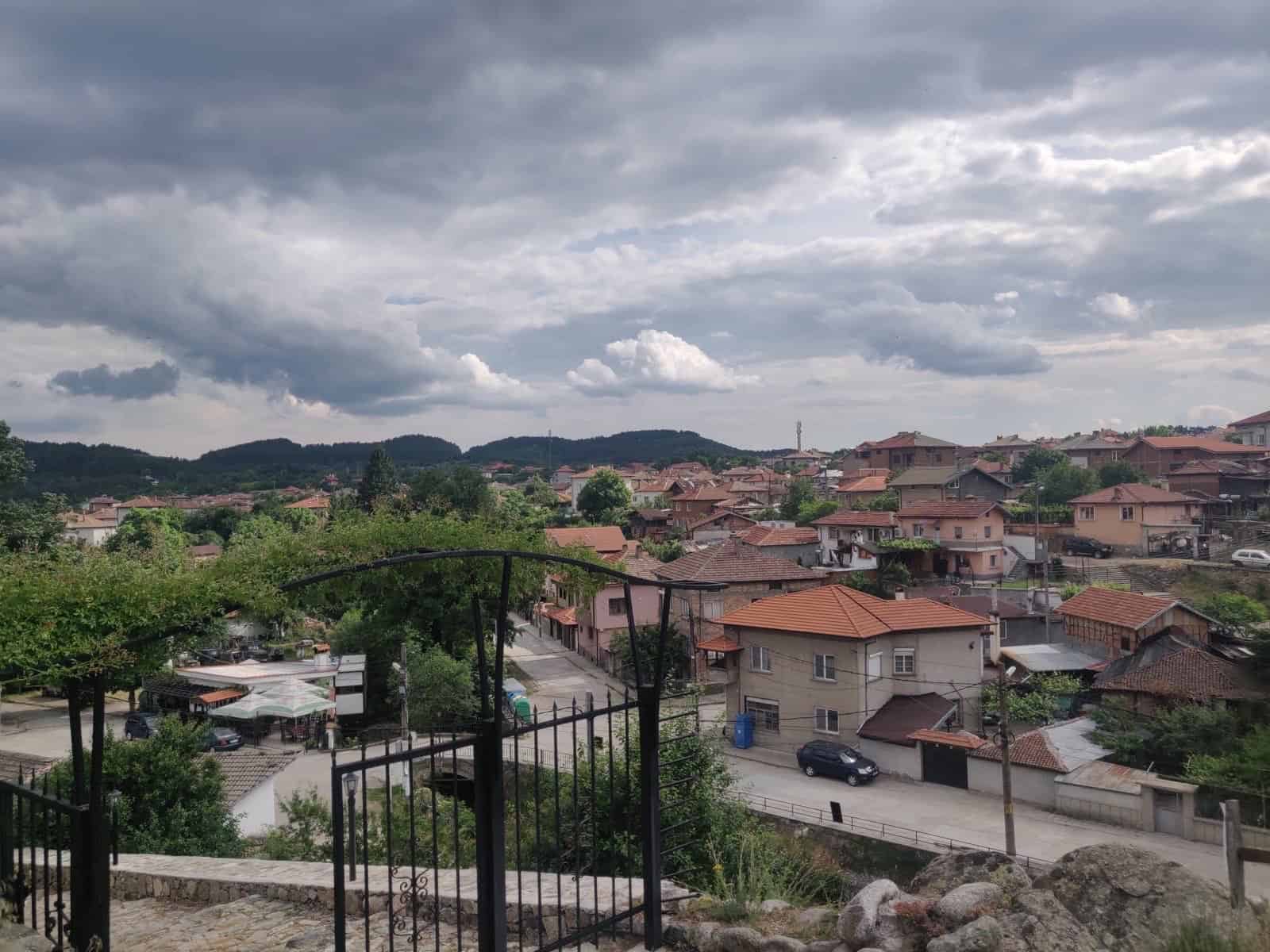
I had really begun enjoying the Bulgarian salad culture. Restaurant menus in Bulgaria follow a pattern: the food is all very cheap, but appears all the cheaper on paper because one is often left to construct your own meal — the menu will have lots of cooked or prepared parts (like grilled chicken or sautéed mushrooms etc.) but if you order that alone, it will look rather lonely on the plate. I soon gathered that the idea is to combine things, as it is uncommon to find that dishes act as centrepieces to the rest of the plate (i.e. pork would, in other countries, come with a side salad or potatoes etc. whereas here, you get the pleasure of customisation).
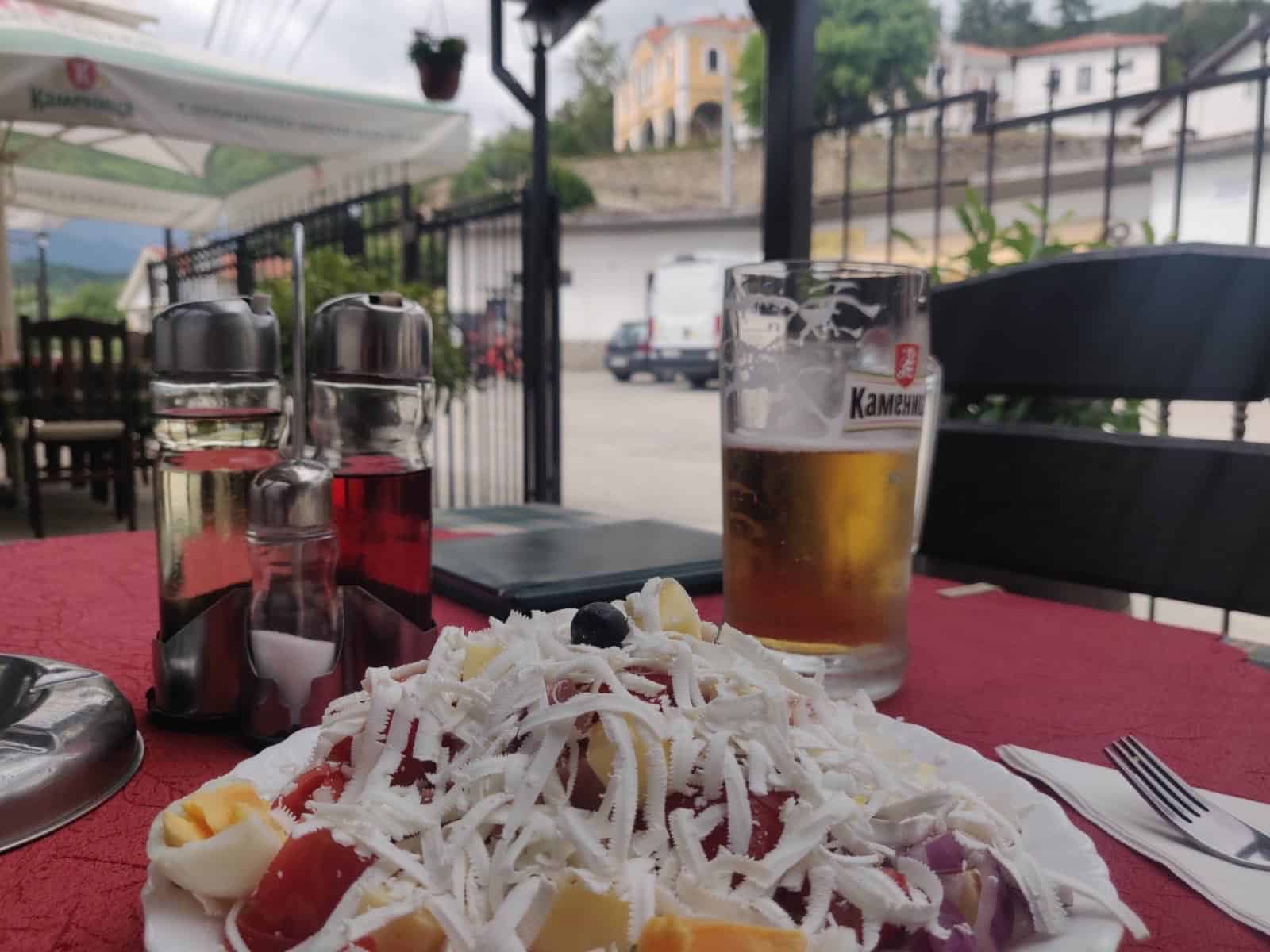
Approaching Plovdiv
Up and down the foothills I went for most of the day, before finally turning south at Banya. Road-side walking (and much bad driving) was a grind, but fields of light pink roses were never far off.
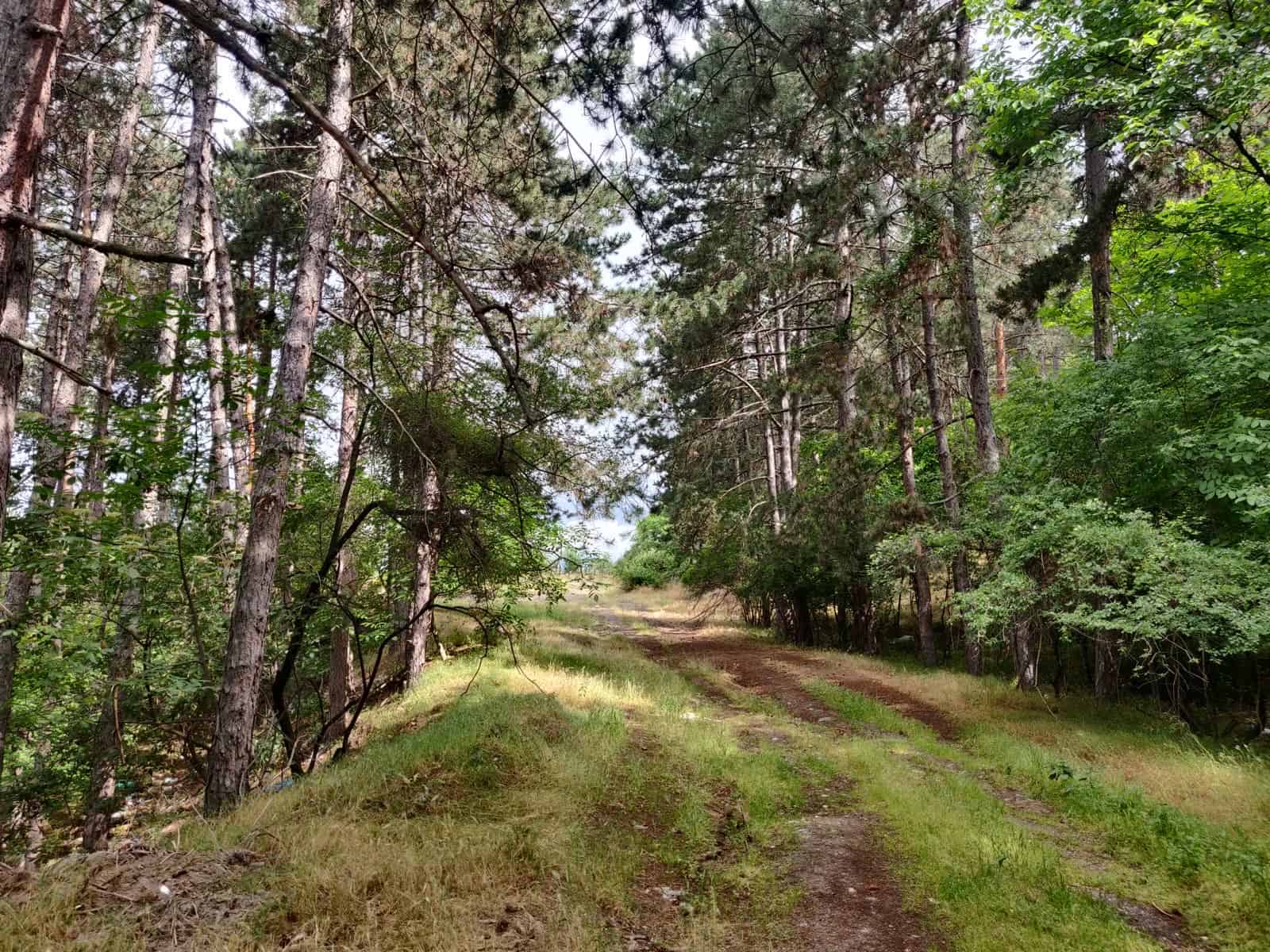
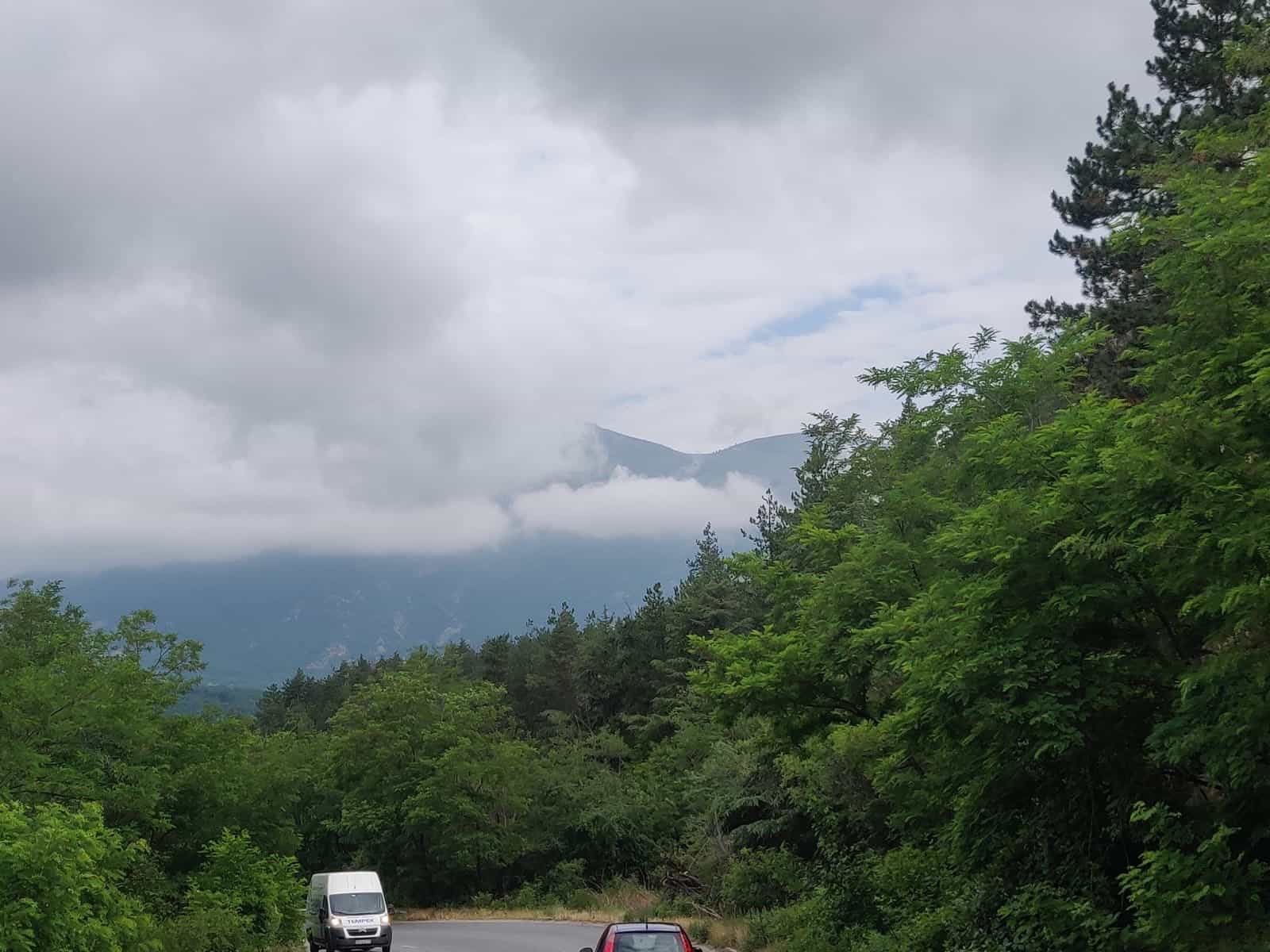
Throughout the day, new ranges and peaks seemed to spring up; they didn’t appear tethered to the northern or southern range — I was always surrounded. Often, when I turned around, the mountains and peaks would appear even higher in the sky, growing behind me. And, finally, the foothills gave way to plains.
Villages like Pesnopoi had a fairly abandoned feel to them. Roosters and hens roamed the streets, whilst the odd lone horse could be seen occupying the fields around town. The low grumble of a storm up in the mountains caused me to turn; I pulled down my hood and shuffled quickly southwards, towards Plovdiv.
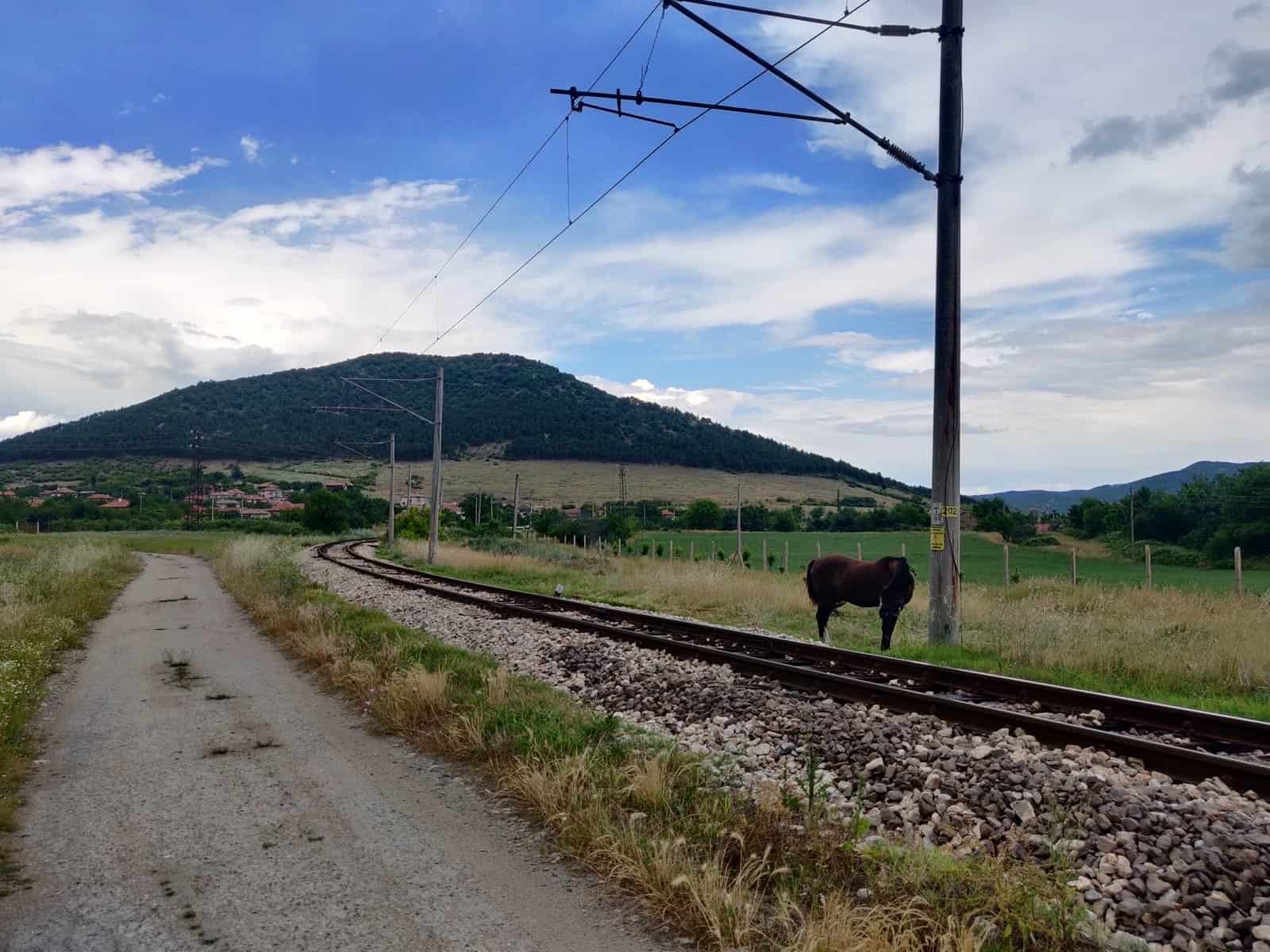

Oh so wonderful and inspiring. I will never be able to visit the places you and walked to Noah!
And it is so nice to read about them, the generous people you meet (and animals!) The countryside seems
to be not overly industrialized.. lots of farms. Thanks so much for sharing your great adventures!!
Thank you, Nelly! I’m so glad you enjoyed 🙂
Wow, that brother of yours seems like a good egg!
What a wonderfully wide world we live in. These do touch off such a paroxysm of faith that life is happening!
A good egg, indeed. Though his recent ramblings suggest he has aged rapidly into the reminiscences of an old man!